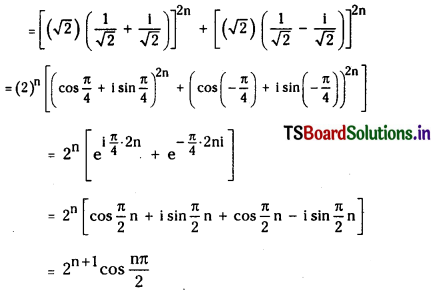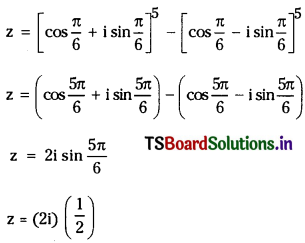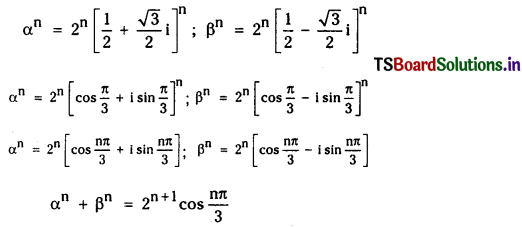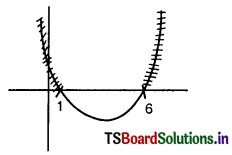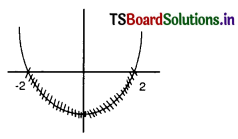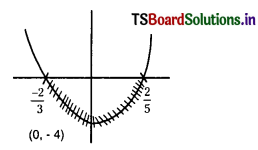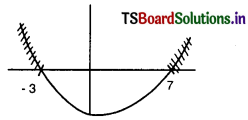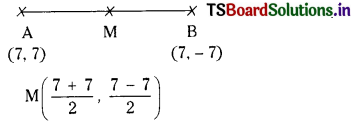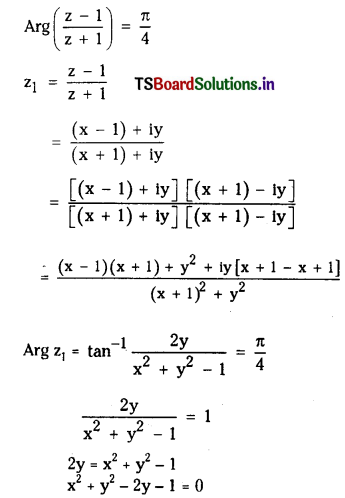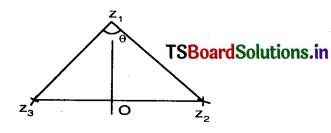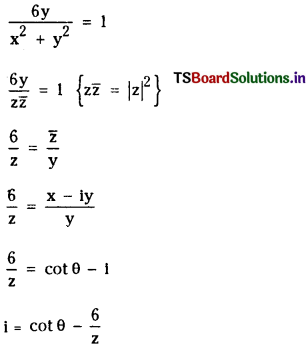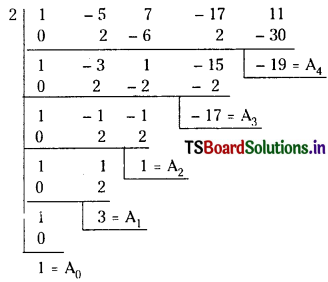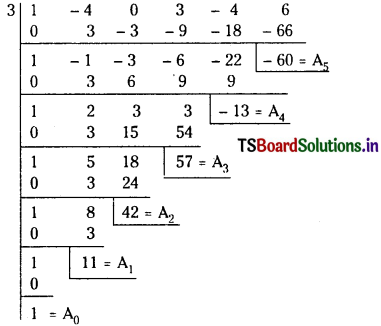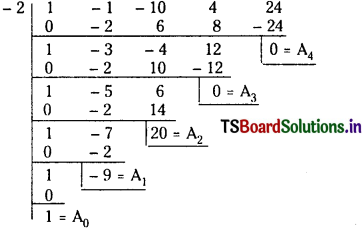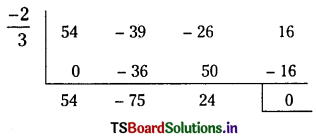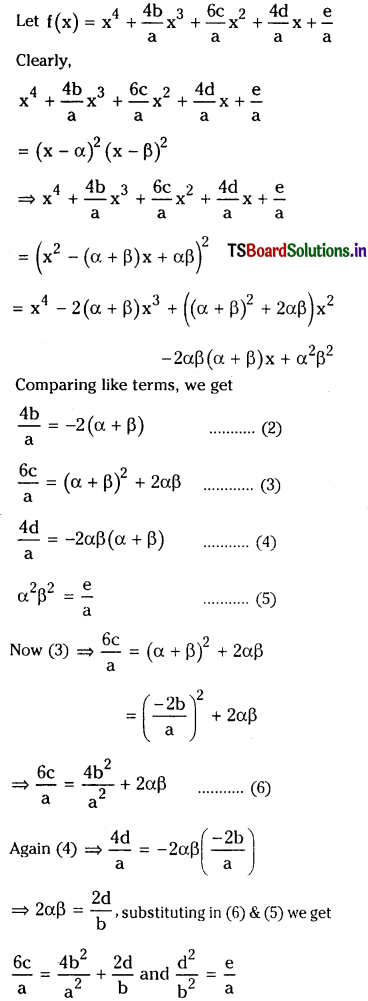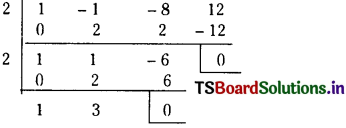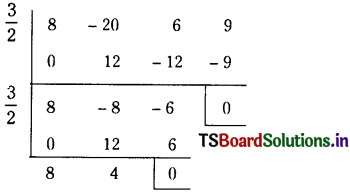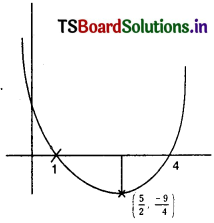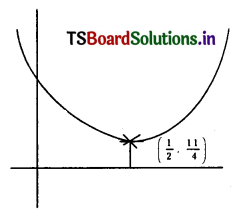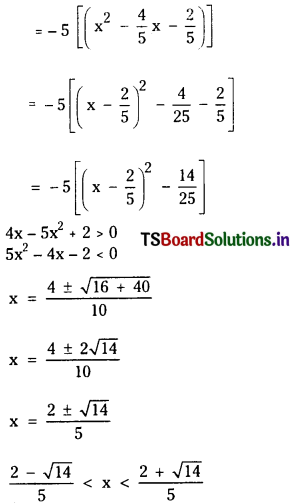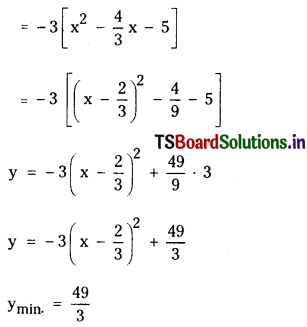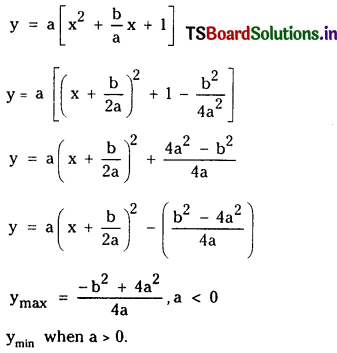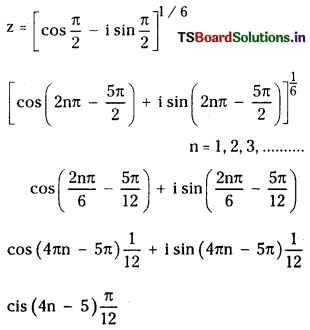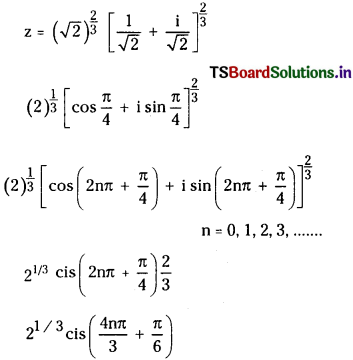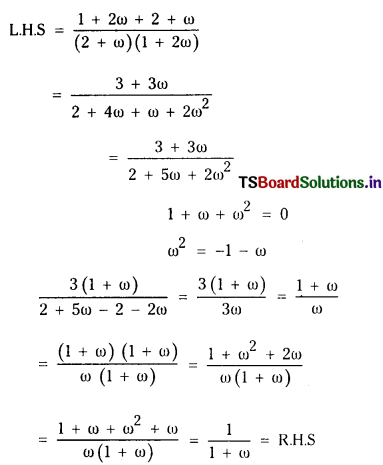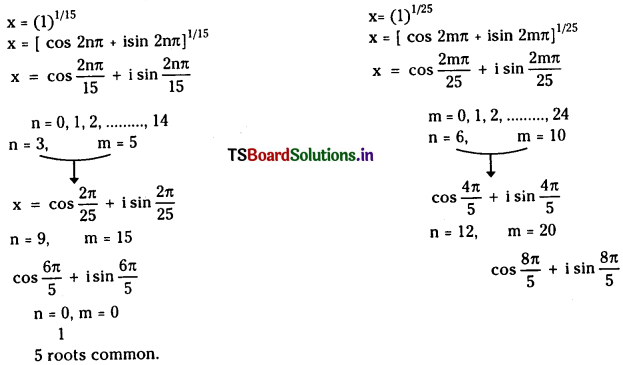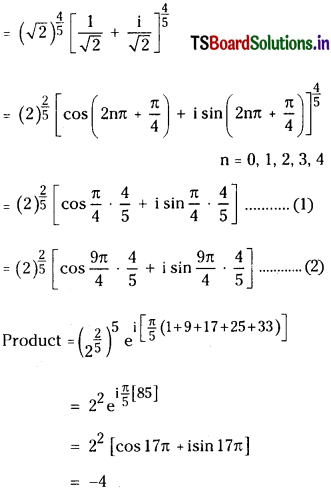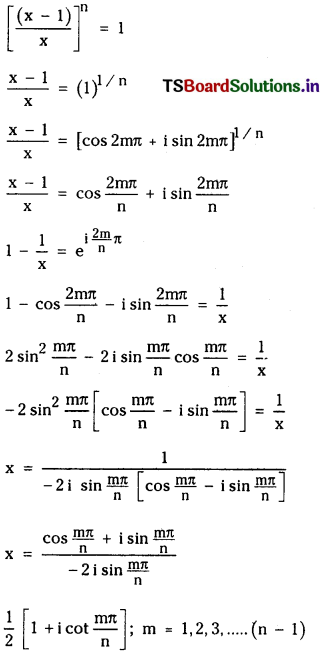Telangana TSBIE TS Inter 2nd Year Telugu Study Material 1st Poem శ్రీకృష్ణ రాయబారం Textbook Questions and Answers.
TS Inter 2nd Year Telugu Study Material 1st Poem శ్రీకృష్ణ రాయబారం
అభ్యాసం
I. వ్యాసరూప ప్రశ్నలు
ప్రశ్న 1.
శ్రీకృష్ణుని రాయబారాన్ని వివరించండి. (V.Imp)
జవాబు:
“ఓ జననాథ అని శ్రీకృష్ణుడు తన మాటలను ధృతరాష్ట్రుని ఎదుట మొదలు పెట్టాడు. సమాజ సౌఖ్యాన్ని దృష్టిలో పెట్టుకొని నిర్ణయం తీసుకోవాలని సూచించాడు. నీకు తెలియని విషయాలు ఏమున్నాయి ? ఐనప్పటికీ, భరతవంశం సంతోషించేటట్లు మీ ఇరు కుటుంబాల వారికి న్యాయమూ, పరమహితమూ చెప్పటం ఉచితమని నేనిక్కడికి వచ్చాను. మీ ఇద్దరు తనకు సమానమని తెలిపాడు. పాండవులు కౌరవులు పాలూ, నీరూ లాగ కలసి మెలసి జీవించటం మంచిదని వారు కలిసిమెలసి ఉండేటట్లు నడిపించవలసిన బాధ్యత ధృతరాష్ట్రునిదని తెలియపరిచాడు. పాండవులు వేరు, కౌరవులు వేరు అనే భేదభావన చూపకూడదన్నాడు.
భరతవంశం ధర్మం, న్యాయం, సత్యం, ఐకమత్యం, గౌరవం, కారుణ్యం మొదలైన సద్గుణాలు గలిగి కీర్తి పొందిందని తెలిపి దానిని కాపాడాలన్నాడు. కురు వంశములో పెద్దవాడివి కావున నీ కుటుంబంలోని వారి నడవడికల బాధ్యత నీదే అన్నాడు.
యుద్ధం వస్తే అక్కడున్న భీమార్జునులను యుద్ధరంగంలో మించేవారు ఇక్కడెందరున్నారు ? ఇక్కడున్న ద్రోణ, భీష్ముల పరాక్రమాన్ని ఎదుర్కొనగలవారు అక్కడ కూడా లేరు. ఇట్లా ఉభయ పక్షాలలోని వీరులు యుద్ధంలో చావటం కన్న నీ బలగాలన్నీ కలసి మెలసి వర్తించటం మంచిదని హితవు పలికాడు. రాజా ! నీవు కురుపాండవుల విషయంలో శ్రద్ధ వహించకుంటే ఈ ఉభయ వర్గాలకే కాదు, పుడమిలోని జనులందరికీ హాని చేసినట్లే అవుతుందని, ఆ కీడు నీకే కలుగుతుందని హెచ్చరించాడు.
రాజా ! కురు పాండవులలో ఎవరికి మరణం సంప్రాప్తించినా, బాధలు కలిగినా, నీకు దుఃఖం కలుగుతుంది. కౌరవ పాండవుల కోమలమైన శరీరాల నుండి మొనలుదేలిన బాణాలు ఆవలికి దూసుకొని వెళ్ళేటట్లు గ్రుచ్చుకోగా నేలమీద కూలటం చూచి సహించటం సరైనది కాదు కావున కురుపాండవులు సంగ్రామంలో నశించకుండా సంరక్షించుకోవాలని చెప్పాడు. పాండురాజు చనిపోయిన తరువాత వారిని చక్కగా పెంచిన నీవు ఇప్పుడు వారికి అన్యాయం చేయడం సరికాదన్నాడు. పాండవుల శక్తియుక్తులను గుర్తు చేస్తూ వారి ఔదార్యాన్ని వివరించాడు. ఉత్తమమైన ధర్మం, నిర్మలమైన సత్యం పాపం చేతను, అబద్ధం చేత లక్ష్యాన్ని చేరలేని స్థితిలో భగవంతుడు ధర్మమును ఉద్ధరించటానికి, సత్యానికి శుభం కలిగించటానికి ముందుకు వస్తాడని తెలిపాడు.
నీ పుత్రుడైన దుర్యోధనుడి అకృత్యాలకు పరోక్షంగా మద్దతు తెలిపినందుకు మీకందరికి తగిన శిక్ష పడుతుందన్నాడు. దుర్యోధనుని మనసులో ఉన్న పరమ దురాశను తొలగించి, పాండవులకు రావలసిన అర్థ రాజ్యాన్ని వారికి అప్పగించేలా చూడాలని చెప్పాడు. పాండవులను నీ చెంతకు పిలిపించుకోమన్నాడు.
పాండవులు ఎంతటి శాంత స్వభావులో అంతటి వీరాగ్రేసరులు. వారికి మీతో కలసి మెలసి ఉండటం ఇష్టం కాకపోతే ఈపాటికి యుద్ధానికి బయలుదేరి వచ్చేవారు. సంధి, సంగ్రామం ఈ రెండింటిలో మీకేది హితమని తోస్తుందో దానిని నిర్ణయించి వెల్లడించమని పలికాడు. ఈ విధంగా శ్రీకృష్ణుడు కౌరవ వంశ ప్రతిష్టను, దుర్యోధనాదుల దుష్టబుద్ధిని, పాండవుల పరాక్రమాన్ని, ఔదార్యాన్ని తెలిపి సంధి చేసుకోకుంటే వచ్చే అనర్థాలను తన రాయబారం ద్వారా వివరించాడు.
ప్రశ్న 2.
యుద్ధం వల్ల జరిగే నష్టాల్ని శ్రీకృష్ణుడు ఏ విధంగా వివరించాడు ?
జవాబు:
యుద్ధం జరిగితే అక్కడున్న భీమార్జునులను యుద్ధరంగంలో ఎదిరించేవారు ఇక్కడెందరున్నారు ? ఇక్కడున్న ద్రోణ, భీష్ముల పరాక్రమాన్ని ఎదుర్కొనగలవారు అక్కడ ఎందరున్నారు ? ఇట్లా ఉభయ పక్షాలలోని వీరులు యుద్ధంలో చావటం కన్న నీ బలగాలై కలసి మెలసి వర్తించటం మంచిది అని హితము పలికాడు. కురు పాండవులలో ఎవరికి మరణం సంప్రాప్తించినా, ఎవరికీ బాధలు కలిగినా ధృతరాష్ట్రునికే దుఃఖం కలుగుతుందని
తెలిపాడు. కౌరవులూ, పాండవులూ మంచి చదువరులు, పరాక్రమవంతులు, భుజదర్పం గలవారు గనుక ఎవ్వరూ వీరి నడ్డగించలేరు. ఇట్లాంటివారు తమలో తమకేర్పడిన యుద్ధంలో మరణించటానికి సిద్ధపడుతుండగా అడ్డుపడక చూస్తూ ఊరకుండటం నీ వంటి వారికి తగిన పని కాదు. ఎంతో కోమలమైన వారి శరీరాల నుండి మొనలుదేలిన బాణాలు దూసుకొని వెళ్ళేటట్లు గ్రుచ్చుకోగా నేలమీద కూలటం చూచి సహించటం సరైనది కాదు. రాజా ! నీ గొప్పతనమును రాజనీతినీ, శాంతిని సమస్త ప్రజలు మెచ్చుకొనేటట్లు కురుపాండవులు సంగ్రామంలో నశించకుండా సంరక్షించుకొనుము అని శ్రీకృష్ణుడు చెప్పడంలో భవిష్యత్ కాలంలో జరిగే అనర్థాలు స్ఫురిస్తాయి. యుద్ధమైతే అందరికీ మహాపద కలుగుతుంది. దాన్ని లెక్కలోనికి తీసుకోవాలన్నాడు.
కౌరవ, పాండవ యుద్ధంలో యాదవ కుటుంబ సభ్యులు కొందరైనాపోవటం శ్రీకృష్ణుడికేర్పడే ఆపద. కొడుకులందరూ మరణించి తర్పణాలు ఇవ్వటానికి కూడా ఎవ్వరూ మిగలని మహాపద ధృతరాష్ట్రుడిది. కౌరవులందరూ నశించటం వంశజుల కేర్పడే మహాపద. యుద్ధంలో సహాయపడే రాజులు కోల్పోతారు. దానివలన భూమి వీరులను కోల్పోతుంది. రక్తంతో తడుస్తుంది. జననాశం ఏర్పడుతుంది. వితంతువుల విషాదం పెల్లుబికుతుంది. ఇవన్నీ లోకానికేర్పడే ఆపదలు, వీటిని పరిగణించి తప్పక సంధి చేయుమని హితవు చెప్పి హెచ్చరించాడు శ్రీకృష్ణుడు.

II సంగ్రహరూప ప్రశ్నలు
ప్రశ్న 1.
సభలో శ్రీకృష్ణుడు ఎలా ఉన్నాడు ?
జవాబు:
ధృతరాష్ట్రుని సభలో శ్రీకృష్ణుని కంఠస్వరం మేఘ గర్జన లాగా గంభీరంగా, హృదయంగమంగా ఉంది. ఆయన దంతాల కాంతులు మెరుపులవలె ప్రకాశిస్తున్నాయి. వర్షాకాల ప్రకృతి రమణీయతతో శ్రీకృష్ణుణ్ణి తిక్కన పోల్చి ఉపమాలంకారంతో చెప్పాడు. గంభీరమైన సన్నివేశాన్ని గంభీరంగా తిక్కన చిత్రించాడు.
ప్రశ్న 2.
శ్రీకృష్ణుడు ఎందుకు వచ్చానన్నాడు ?
జవాబు:
ధృతరాష్ట్రుని సభలో ఉన్న వారందరూ శ్రద్ధగా వింటుండగా పాండవులు పంపిన సంధి సమాచారాన్ని ధృతరాష్ట్ర మహారాజుతో చెప్పాడు. “ఓ జననాథ ! నీకు తెలియని విషయాలు ఏమున్నాయి ? ఐనప్పటికీ, భరతవంశం సంతోషించేటట్లు నా ఇరు కుటుంబాల వారికి న్యాయమూ, పరమహితమూ చెప్పటం ఉచితమని నేనిక్కడికి వచ్చాను అని శ్రీకృష్ణుడు అన్నాడు. ఇందులో జననాథ అనడం ద్వారా కేవలం నీ కొడుకుల గురించి మాత్రమే కాకుండా సమస్త ప్రజల గురించి ఆలోచించాలి అనే విషయాన్ని గుర్తు చేశాడు.
నీకు తెలియని విషయాలు ఏమున్నాయి అనడం ద్వారా తన విషయాన్ని ప్రదర్శించాడు. ఇరు కుటుంబాల వారికి అనడం ద్వారా కౌరవ పాండవులు ఇరువురు తనకు కావలసిన వారే అని చెప్పాడు. న్యాయము, పరమ హితము చెప్పడానికి వచ్చాననడం లోకకళ్యాణాన్ని సూచిస్తుంది. కావున శ్రీకృష్ణుడు లోకకళ్యాణం కోసం యుద్ధాన్ని మాన్పించడానికి వచ్చానని చెప్పాడు.
ప్రశ్న 3.
భరతవంశం గొప్పతనం తెలుపండి.
జవాబు:
భరతవంశం ధర్మం, న్యాయం, సత్యం, ఐకమత్యం, గౌరవం, కారుణ్యం అనే ఆరు గుణాలకు ప్రసిద్ధి. ఆ భరత వంశంలో పుట్టిన వారందరూ పై సద్గుణాలు గలిగి కీర్తి పొందారు. అట్టి వంశంలో నీవూ, నీ ప్రియ సహోదరుడు పాండురాజూ సద్గుణాలయందు శ్రేష్టులు అనడంలో పాండురాజు ఔన్నత్యం తెలపడంతోపాటు ధృతరాష్ట్రుని ముందు కాళ్ళకి బంధం వేయడం కనిపిస్తుంది. నీ కుమారులు కూడా కీర్తి భారం వహించ జాలినవారు అవడం వల్ల యుద్ధం చేసి చెడ్డపేరు పొందకూడదు అనే సూచనా కనిపిస్తుంది.

ప్రశ్న 4.
సారపు ధర్మం ఎలాంటిది ?
జవాబు:
ధర్మం ఎప్పుడూ సారవంతమైనది. శక్తివంతమైనదే, సత్యం ఎల్లప్పుడూ కల్మషం లేనిదే, నిర్మలమైనదే, స్వచ్ఛమైనదే. అవి రెండు స్వయం సమర్థములైనవే. అయితే వాటిని వ్యతిరేకించేవీ, కలతపెట్టేవీ, నశింపజేయ యత్నించేవి పాపం, అసత్యం. సత్యధర్మాలు ఫలవంతమయ్యే తరుణంలో పాపం, అబద్ధాలు అడ్డుపడి చెడగొట్టే యత్నాలు చేస్తాయి. కాని, అవి చెడిపోవు. ధర్మాన్ని రక్షించేవారు దానికొరకు తమ శక్తిని ధారపోయాలి. సత్యాన్ని రక్షించేవారు సత్యాచరణంలో త్రికరణశుద్ధిని ప్రదర్శించాలి.
అప్పుడు ధర్మసత్యాలు తమ సార నిర్మలత్వాలను రక్షించుకో గలుగుతాయి. దీనిని తెలిసిన విజ్ఞులు తమ బాధ్యతను తెలుసుకొని వాటిని రక్షించి తమను తాము రక్షించుకోవాలి. ఆ విషయంలో ఉపేక్ష చేస్తే వారి చరిత్రలకు ధర్మసత్య కవచాలు తొలగిపోయి బలహీనులై పాపాలకూ, అసత్యాలకూ బలి అయిపోతారు. దక్షులై కూడా తమ ధర్మాన్ని నిజాయితీతో నిర్వహించని వారికి చేటు రాకతప్పదని ఈ సందేశం.
III ఏకపద / వాక్య సమాధాన ప్రశ్నలు
ప్రశ్న 1.
కౌరవ సభకు రాయబారిగా ఎవరు వచ్చారు ?
జవాబు:
శ్రీకృష్ణుడు
ప్రశ్న 2.
కౌరవపాండవులు వేటిలాగా కలిసి ఉండాలని కృష్ణుడు చెప్పాడు ?
జవాబు:
పాలు నీళ్ళు లాగ
ప్రశ్న 3.
యుద్ధం సంభవిస్తే ఏం జరుగుతుంది ?
జవాబు:
యుద్ధం సంభవిస్తే చాలా త్వరగా కురువంశానికి, రాజులకు మహాపద కలుగుతుంది.
ప్రశ్న 4.
సంధికార్యం ఎవరి చేతిలో ఉంది ?
జవాబు:
ధృతరాష్ట్రుని
ప్రశ్న 5.
తిక్కన ఎవరి ఆస్థాన కవి ?
జవాబు:
తిక్కన నెల్లూరు మండలాన్ని పరిపాలించిన మనుమసిద్ధి యొక్క ఆస్థానకవి.
ప్రశ్న 6.
శాంతశూరులు ఎవరు ?
జవాబు:
పాండవులు

ప్రశ్న 7.
తిక్కన రచనలు తెలుపండి.
జవాబు:
తిక్కన, ఆంధ్ర మహాభారతంలో విరాటపర్వము నుండి స్వర్గారోహణ పర్వం వరకూ ఆంధ్రీకరించాడు. ఇదికాక
- నిర్వచనోత్తర రామాయణం
- కృష్ణశతకం
- విజయసేనం
- కవివాగ్బంధం-మొదలైన రచనలు చేశాడు.
ప్రశ్న 8.
తీక్కన సోమయాజ మహాభారతం ఎవరికి వినిపించాడు ? (V.Imp) (M.P.)
జవాబు:
హరి హర నాథునికి
IV సందర్భసహిత వ్యాఖ్యలు
1. సుచరితక్రమమిప్పుడు తప్పనేటికిన్ (V.Imp) (M.P.)
కవి పరిచయం : ఈ వాక్యం తిక్కన రాసిన మహాభారతం ఉద్యోగ పర్వం తృతీయాశ్వాసం నుండి తీసుకున్న శ్రీకృష్ణ రాయబారం అనే పాఠ్యాంశంలోనిది. తిక్కనకు ఉభయకవి మిత్రుడు అనే బిరుదు ఉంది. పదమూడవ శతాబ్దికి చెందిన నెల్లూరు పాలకుడు మనుమసిద్ధి ఆస్థానంలో ఉండేవాడు.
సందర్భం : శ్రీకృష్ణుడు ధృతరాష్ట్రునికి భరతవంశ ప్రాశస్త్యాన్ని వివరిస్తున్న సందర్భంలోనిది.
అర్థం : మంచి వంశ క్రమాన్ని ఇప్పుడు ఎందుకు తప్పుతారు ?
వివరణ : మహారాజా ! మీ భరతవంశం ధర్మం, న్యాయం, సత్యం, ఐకమత్యం, గౌరవం, కారుణ్యం మొదలైన సద్గుణాలు గలిగి కీర్తి పొందింది. అట్టి వంశంలో నీవూ, నీ ప్రియ సహోదరుడు పాండురాజూ, సద్గుణాలయందు శ్రేష్టులు, మరి నీ కుమారులూ కీర్తి భారం వహించ జాలినవారు. కళ్యాణ స్వభావులు. ఇంత మంచి నడవడిగల వంశ సంప్రదాయం ఇప్పుడు కూడా తప్పించడం ఎందుకు ? అని శ్రీకృష్ణుడు ధృతరాష్ట్రునితో అన్నాడు.
2. ప్రజల యెడ విరోధంబు వాటించుటెంతమేలు (V.Imp)
కవి పరిచయం : ఈ వాక్యం తిక్కన రాసిన మహాభారతం ఉద్యోగపర్వం తృతీయాశ్వాసం నుండి తీసుకున్న శ్రీకృష్ణ రాయబారం అనే పాఠ్యాంశంలోనిది. తిక్కనకు ఉభయకవి మిత్రుడు అనే బిరుదు ఉంది. పదమూడవ శతాబ్దికి చెందిన నెల్లూరు పాలకుడు మనుమసిద్ధి ఆస్థానంలో ఉండేవాడు.
సందర్భం : శ్రీకృష్ణుడు ధృతరాష్ట్రునికి యుద్ధం వల్ల కలిగే నష్టాన్ని వివరిస్తున్న సందర్భంలోనిది.
అర్థం : మీ పిల్లల పట్ల నిర్లక్ష్యం వహించడం సరైనదేనా ?
వివరణ : లోకంలోని రాజులందరూ నీ పాదపీఠాన్ని ప్రీతితో సేవిస్తుండగా సముద్రపు చెలియలికట్టచేత చుట్టబడిన పుడమినంతటిని నీవే ఏకచ్ఛత్రంగా పరిపాలించటం తగును, తల్లి తన బిడ్డలపట్ల శత్రుత్వం వహించటం ఎంత సమంజసమో నీవే ఆలోచించు అని శ్రీకృష్ణుడు ధృతరాష్ట్రునితో అన్నాడు.
3. దురితంబొనరించిట్ల తుదిఁ గీడు సుమీ (V.Imp)
కవి పరిచయం : ఈ వాక్యం తిక్కన రాసిన మహాభారతం ఉద్యోగ పర్వం తృతీయాశ్వాసం నుండి తీసుకున్న శ్రీకృష్ణ రాయబారం అనే పాఠ్యాంశంలోనిది. తిక్కనకు ఉభయకవి మిత్రుడు అనే బిరుదు ఉంది. పదమూడవ శతాబ్దికి చెందిన నెల్లూరు పాలకుడు మనుమసిద్ధి ఆస్థానంలో ఉండేవాడు.
సందర్భం : శ్రీకృష్ణుడు ధృతరాష్ట్రునికి తన బాధ్యతను గుర్తుచేస్తున్న సందర్భంలోనిది.
అర్థం : జనులందరికీ పాపం చేసినట్లే ఔతుంది. చివరకు మీకే కీడు కలుగుతుంది.
వివరణ : రాజా ! నీవు కురుపాండవుల విషయంలో శ్రద్ధ వహించకుంటే ఈ ఉభయ వర్గాలకే కాదు, పుడమిలోని జనులందరికీ పాపం చేసినట్లే ఔతుంది. చివరకు నీకే హాని కలుగుతుంది అని శ్రీకృష్ణుడు ధృతరాష్ట్రునితో అన్నాడు.
4. సత్యశుభదాయకమయ్యును దైవముండెడున్ (V.Imp)
కవి పరిచయం : ఈ వాక్యం తిక్కన రాసిన మహాభారతం ఉద్యోగ పర్వం తృతీయాశ్వాసం నుండి తీసుకున్న శ్రీకృష్ణ రాయబారం అనే పాఠ్యాంశంలోనిది. తిక్కనకు ఉభయకవి మిత్రుడు అనే బిరుదు ఉంది. పదమూడవ శతాబ్దికి చెందిన నెల్లూరు పాలకుడు మనుమసిద్ధి ఆస్థానంలో ఉండేవాడు.
సందర్భం : శ్రీకృష్ణుడు ధృతరాష్ట్రునికి సంధి చేసుకోకుంటే దైవం తన పని తాను చేస్తాడని హెచ్చరిస్తున్న సందర్భంలోనిది.
అర్థం : సత్యమునకు శుభం కలిగించటానికి భగవంతుడు ముందుకు వస్తాడు.
వివరణ : ఉత్తమమైన ధర్మం, నిర్మలమైన సత్యం పాపం చేతను, అబద్దం చేత దరి చేరలేక చెడటానికి సంసిద్ధంగా ఉన్న స్థితిలో వాటిని రక్షించే శక్తి ఉన్నా ఎవరు అడ్డుపడక అశ్రద్ధ వహిస్తారో అది వారలకే హానికరమవుతుంది. ఆ స్థితిలో భగవంతుడు ధర్మమును ఉద్ధరించటానికి, సత్యమునకు శుభం కలిగించటానికి ముందుకు వస్తాడు అని శ్రీకృష్ణుడు ధృతరాష్ట్రునితో అన్నాడు.
పద్యములు – ప్రతిపదార్థ – తాత్పర్యములు
1వ పద్యం :
కం॥ జలదస్వన గంభీరత
నెలుఁగొప్పఁగ దంత దీప్తు లెసగ ముకుందుం
డలరుచు సభ నఖిల జనం
బులు విన ధృతరాష్ట్ర భూవిభున కిట్లనియెన్
ప్రతిపదార్థం:
ముకుందుఁడు = శ్రీకృష్ణుడు
జలదస్వన గంభీరతన్ = మేఘ ధ్వని యొక్క గాంభీర్యంతో
ఎలుగు + ఒప్పన్ = తన కంఠ ధ్వని సొంపారగా
దంత దీప్తులు + ఎసగన్ = దంతాల యొక్క కాంతులు అతిశయించగా
సభన్ = సభలో
అలరుచున్ = ప్రకాశిస్తూ
అఖిలజనంబులు = ధృతరాష్ట్రుడి కొలువులో ఉన్న సమస్త ప్రజలు
వినన్ = వింటుండగా
ధృతరాష్ట్ర భూవిభునకు = ధృతరాష్ట్ర మహారాజుకు
ఇట్లు + అనియెన్ = ఈ విధంగా అన్నాడు.
తాత్పర్యం : శ్రీకృష్ణుడు మేఘధ్వనివలె గంభీరమైన తన కంఠధ్వనితో, దంత కాంతులు ప్రసరిస్తూ ఉండగా, సభలో వెలుగొందుతూ, సదస్యులందరూ చెవులు నిక్కరించుకొని ఆలకిస్తుండగా ధృతరాష్ట్ర మహారాజుతో ఇలా అన్నాడు.
విశేషం :
- కృష్ణుని కంఠస్వర గాంభీర్యం, సభ్యులను పరవశింప చేస్తున్నదని, కవి తిక్కన ఇందులో సూచిస్తున్నాడు.
- జలదస్వనానికి అనగా ఉరుముకు తోడుగా, దంతదీప్తులు మేఘము నుండి వచ్చే మెఱపులుగా భాసిస్తున్నాయని, కవి ఇక్కడ సూచించాడు.

2వ పద్యం :
కం॥ జననాథ ! నీ యెఱుంగని
పనులు గలవె ? యైనఁ దగవుఁ బరహితంబుం
దనవారికిఁ జెప్పగ తగు
నని వచ్చితి భారతాన్వయము ప్రియమొందన్
ప్రతిపదార్థం :
జననాథ = ఓ మహారాజా (ధృతరాష్ట్ర చక్రవర్తీ !)
నీ యెఱుంగని పనులు
(నీ + ఎఱుంగని, పనులు) = నీకు తెలియని పనులు
కలవె (కలవు + ఎ) = ఉన్నాయా ? (లేవని భావము)
ఐనన్ = అయినప్పటికీ
తన వారికిన్ = తన బంధువులకు
తగవున్ = న్యాయమునూ, ధర్మమునూ
పరమ హితంబున్ = ఉత్తమమయిన మంచి (మంచి మాట) నూ
చెప్పన (చెప్పన్ + అ) = చెప్పడమే
తగునని (తగును + అని) = ధర్మమని
భారతాన్వయము (భారత + అన్వయము) = భరత వంశము
ప్రియమొందన్
(ప్రియము + ఒందన్) = సంతోషపడేటట్లు
వచ్చితిన్ = (నేను) ఇక్కడికి వచ్చాను
తాత్పర్యం : ధృతరాష్ట్ర మహారాజా ! నీకు తెలియని విషయాలు ఏమున్నాయి ? అయినా, తన చుట్టాలకు న్యాయాన్నీ, ఉపయోగపడే మంచిమాటనూ చెప్పడమే ధర్మము అనే భావంతో, భారత వంశీయులు అందరూ, సంతోషపడతారని, నేను ఇక్కడికి వచ్చాను.
3వ పద్యం :
కం॥ క్షీరోదక గతిఁ బాండవ
కౌరవు లొడఁగూడి మనికి కార్యం ఐది నీ
వారసి నడపుము వా రన
నీ రనఁ గురుముఖ్య ! నీకు వేఱుంగలదే ?
ప్రతిపదార్థం :
కురుముఖ్య ! = కురువంశంలో ప్రధానమైనవాడా !
క్షీర + ఉదక గతిన్ = పాలూ, నీరు లాగ
పాండవ కౌరవులు = పాండవులు, కౌరవులు
ఒడన్ + కూడి = కలిసి మెలిసి
మనికి = జీవించటం
కార్య౦బు = చేయదగ్గ పని
అది = దానిని
నీవు = నీవు
ఆరసి = పరిశీలించి
నడపుము = సాగించుము
నీకున్ = నీకు
వారు + అనన్ = పాండవులనగా
వీరు + అనన్ = కౌరవులు అనగా
వేఱుం + కలదే = భేదమున్నదా? (లేదని అర్థం)
తాత్పర్యం : కురునాథా ! పాండవ కౌరవులు పాలూ నీరూ వలె కలసిమెలసి జీవించటం మంచిపని. వారు అట్లా ఒద్దికతో ఉండేటట్లు నీవు వారిని నడపించవలసి ఉంది. పాండవులు వేరు, కౌరవులు వేరు అనే భేదభావన నీకు లేదు కదా !
4వ పద్యం :
శా ||
ఈ వంశంబున కెల్ల నీవ కుదు; రిం దెవ్వారి చందంబు లె
ట్లై వర్తిల్లినఁ గీడు మేలుఁ దుది నీయం దొందెడు గాన స
ద్భావం బారసి లోనిపొత్తు వెలివృత్తంబున్ జనస్తుత్యముల్
గావింపం దగు నీక యెవ్విధమునం గౌరవ్యవంశాగ్రణీ!
ప్రతిపదార్థం :
కౌరవ్యవంశ + అగ్రణి = కురువంశంలో శ్రేష్టుడా!
ఈ వంశంబునకున్ + ఎల్లన్ = ఈ కురుకులాని కంతటికి
నీవు + అ (నీవ) = నీవే
కుదురు = ఆశ్రయం (మూలం)
ఇందున్ = ఈ కురువంశస్థులలో
ఎవ్వారి చందంబులు = ఎవ్వరి నడవడులు
ఎట్లు + ఐ వర్తిల్లినన్ = ఏ విధంగా ఉండునో వాటిననసరించి
కీడు = హాని
మేలూ = వృద్ధి
తుదిన్ = కడపటి
నీ అందున్ + ఒందెడున్ = నీకే చెందగలవు
కానన్ = కనుక
సద్భావంబు + అరిసి = మంచి తలంపునకు వచ్చి
లోనిపొత్తు = అంతరంగంలో ఒద్దిక
వెలి వృత్తంబున్ = బహిరంగ ప్రవర్తన
జనస్తుత్యముల్ = ప్రజలచేత మెచ్చదగినవిగా
కావింపన్ = చేయటానికి
నీకున్ + అ(నీక) = నీకే
ఏ విధమునన్ = ఏ విధంగానైనా
తగున్ = యోగ్య౦
తాత్పర్యం : ధృతరాష్ట్ర మహారాజా ! నీవు కురు వంశంలో ఆగ్రేసరుడివి. ఈ వంశానికంతటికీ నీవే ఆధారం. నీ కుటుంబంలో ఎవ్వరెవ్వరి నడవడికలు ఎట్లుగా ఉంటాయో, వాటిని బట్టి కలిగే మేలు కీడు నీకే చెందుతాయి. కాబట్టి నీవు ఇరుకుటుంబాల వారి శ్రేయస్సు నూహించి అంతరంగంలో స్నేహం, బహిరంగ ప్రవర్తన జనులు మెచ్చేటట్లుగా ఏవిధంగానైనా వారిని చక్కదిద్దవలసి ఉంటుంది.
5వ పద్యం :
చ|| వినుము ! సుయోధనాదులగు వీరు సధర్ములు గాక కార్యము
ల్గొనక మహార్థసిద్ధి యెడలుం దమ కిట్లన కన్వయంబు వ
ర్తనమిది గాదు నాక బెడిదంపుఁదనంబున బంధుకోటికి
న్మనసులు నొవ్వఁగా నవగుణంబులకుం బుయిలోడ రేమియున్
ప్రతిపదార్థం :
వినుము = (మహారాజా) నామాటలాలకించండి
సుయోధన + ఆదులు + అగువీరు = దుర్యోధనుడు మొదలైన నీ కుమారులు
సధర్ములు కాక = ధర్మము ననుసరించే వారు కాక
కార్యముల్ + కొనక = చేయదగిన మంచి పనులు చేయక
ఇట్లు = ఈ రీతిగ మెలగితే
తమకున్ = తమకు
మహా + అర్థసిద్ధి = గొప్ప ప్రయోజనాలు చేకూరుట
ఎడలున్ + అనక = తొలగిపోవునని తలంచక
అన్వయంబు వర్తనము = వంశపు నడవడి
ఇది కాదు = ఇటువంటిది కాదు
నాక = అనక
బెడిదంపు దనంబునన్ = దారుణ స్వభావంతో
బంధుకోటికిన్ = బంధువర్గానికి
మనసులు నొవ్వగాన్ = హృదయాలు వ్యధ చెందేటట్లు
అవగుణంబులకున్ = దుర్గుణాలకు
ఏమియున్ = ఇంచుకయు
బుయి లోడర = వెనుదీయరు
తాత్పర్యం: రాజా ! వినుము. దుర్యోధనాదులైన వీరు ధర్మపరులుగాక, సత్కార్యాలాచరించక ఇట్లా ఉంటే మహార్థసిద్ధికి దూరమవుతామని తలంచక, వంశ నడవడి ఇట్టిది కాదనక ఈ దారుణ బుద్ధితో బంధువుల మనస్సులు బాధ చెందేటట్లుగా దుష్టచేష్టలు చేయటానికి ఏమాత్రం వెనుదీయకున్నారు.

6వ పద్యం :
ఉ ||
కౌరవ పాండవుల్ తెఱఁగు గైకొని శాంతతఁ బొందియున్కి మే
లారయ నాకు నీకుఁ గులమంతకు నీ నృపకోటి కుర్వికిం
బోరితమైన నింతకును బుట్టు మహాపద గావునన్ ధరి
త్రీ రమణాగ్రగణ్య ! గణుతించి యవశ్యముఁ బొం దొనర్పవే !
ప్రతిపదార్థం :
ధరిత్రీ రమణ + అగ్రగణ్య = రాజులలో ఉత్తముడా !
కౌరవపాండవుల్ = కౌరవులూ, పాండవులూ
తెఱగు + కైకొని = సంధి నిర్ణయానికి వచ్చి
శాంతతన్ + పొంది = ప్రసన్నత్వం వహించి
ఉన్కి = ఉండటం
ఆరయున్ = పరికించగా
నాకున్ = నాకును
నీకున్ = నీకును
కులము అంతకున్ = కురువంశానికంతటికి
ఈ నృప కోటికిన్ = ఈ రాజ సమూహానికి
ఉర్వికిన్ = ఈ జగత్తునకూ
మేలు = శ్రేయం (మంచి)
పోరితము + ఐనన్ = యుద్ధం జరిగితే
ఇంతకును = ఈ సమస్తమునకునూ
మహా + ఆపద + పుట్టున్ = గొప్ప విపత్తు సంభవిస్తుంది
కావునన్ = కనుక
గణుతించి = నా మాటలు లెక్కించి
అవశ్యమున్ = తప్పక
పొందు + ఒనర్పవే = సంధి చేసుకోండి
తాత్పర్యం : కౌరవులు పాండవులు ఒక మంచి నిర్ణయానికి వచ్చి, శాంతం వహించి, జీవించటం మంచిది. ఇట్లు వారు ప్రసన్నచిత్తులై ఉండటం నాకూ, నీకూ, కురువంశానికి, ఈ రాజ సమూహానికీ, ఈ భూమండలానికి మంచిది. అట్లాకాక యుద్ధమే సంభవిస్తే మనందరికీ మహా విపత్తు కలుగుతుంది. కనుక రాజోత్తమా! నా మాటలపై విశ్వాసముంచి తప్పక సంధి చేసుకోండి.
7వ పద్యం :
ఉ || అందు వృకోదరార్జునుల నాహవ రంగమునందు మీఱువా
రెందఱో యెన్నుమా యిచట; నీ గురుభీష్ములఁ గ్రేణిసేయువా
రెందఱో; వారు వీరు నని నీల్గుటకంటె భవర్బలంబులై
యందఱుఁగూడు టొప్పదె జనాధిప ! శాంతి యొనర్పు మెమ్మెయిన్
ప్రతిపదార్థం :
అందున్ = అక్కడ ఉన్న
వృకోదర + అర్జునులన్ = భీమార్జునులను
ఆవహరంగమునందున్ = యుద్ధరంగంలో
మీఱువారు = మించగలవారు
ఎందఱో + ఎన్నుమా = ఇక్కడ ఎందరున్నారో నీవే లెక్కించు
ఇచటన్ = ఇక్కడ ఉన్న
ఈ గురు భీష్ములన్ = ఈ ద్రోణుడిని; భీష్ముడిని
క్రేణి + చేయువారు = పరిహరింపగలవారు
ఎందఱో ? = అక్కడెందరున్నారు ?
వారున్, వీరున్ = అక్కడివారూ, ఇక్కడివారూ
అనిన్ = యుద్ధంలో
ఈల్గుట కంటెన్ = చావటం కంటే
భవత్ + బలంబులు + ఐ = నీ బలగాలై
అందరున్ = వీరందరూ
కూడుట + ఒప్పదే = కలసిమెలసి ఉండటం తగదా ?
ఏ + మెయిన్ = ఏ విధంగానైనా
శాంతి + ఒనర్పుము = సంధి చేయుము
తాత్పర్యం : అక్కడున్న భీమార్జులను యుద్ధరంగంలో మించేవారు ఇక్కడెందరున్నారో చెప్పుము ? ఇక్కడున్న ద్రోణభీష్ముల పరాక్రమాన్ని లక్ష్యపెట్టక పరిహసించగలవారు అక్కడ కూడా లేరు. ఇట్లా ఉభయ పక్షాలలోని వీరులు యుద్ధంలో చావటం కన్న నీ బలగాలై కలసి మెలసి వర్తించటం మంచిది. ఏ విధంగానైనా వీరిని శాంతింప జేయుము.
8వ పద్యం :
తే ||
జగతిఁగల జనపతులు నీ చరణపీఠ
మర్థిఁ గొలువ సముద్ర వేలావృతోర్వి
యెల్ల నేలుట యొప్పదే ? తల్లి ప్రజల
యెడ విరోధంబు వాటించు టెంత మేలు ?
ప్రతిపదార్థం :
జగతిన్ + కల = లోకంలో ఉన్న
జనపతులు = రాజులు
నీ చరణ పీఠము = నీ పాదపీఠమును
అర్థిన్ = కోరికలు
కొలువన్ = సేవిస్తుండగా
సముద్ర వేలా + అవృత = సాగరం యొక్క చెలియలి కట్టచేత చుట్టబడిన
ఉర్వి + ఎల్లన్ = పుడమి నంతయు
ఏలుట = నీవు పాలించటం
ఒప్పదే ? = తగదా ?
తల్లి = జనని
ప్రజల + ఎడన్ = తన బిడ్డల విషయంలో
విరోధంబు పాటించుట = వైరం వహించటం
ఎంత మేలు = ఏపాటి మంచిది ?
తాత్పర్యం : లోకంలోని రాజులందరూ నీ పాదపీఠాన్ని ప్రీతితో సేవిస్తుండగా సముద్రపు చెలియలికట్టచేత చుట్టబడిన పుడమినంతటినీ నీవే ఏకచ్ఛత్రంగా పరిపాలించటం తగును. తల్లి తన బిడ్డలపట్ల శత్రుత్వం వహించటం ఎంత సమంజసమో నీవే ఆలోచించు.
9వ పద్యం :
క||
నరనాథ ! నీవుపేక్షా
పరుఁడ వయినఁ గౌరవులక పాండవులక కా
దరయఁగ భూ ప్రజకెల్లను
దురితం బొనరించి నట్ల తుదిఁ గీడు సుమీ !
ప్రతిపదార్థం:
నరనాథ ! = రాజా
నీవు + ఉపేక్షాపరుఁడవు + అయినన్ = ఈ విషయంలో అశ్రద్ధ వహిస్తే
కౌరవులకున్ + ఆ, పాండవులకున్ + ఆ కాదు = కురుపాండవులకే కాదు
అరయగన్ = ఆలోచిస్తే
భూప్రజకున్ + ఎల్లన్ = పుడమిలోని అందరికి
దురితంబు + ఒనరించిన + అట్లు + అ = పాపం చేసినట్లే ఔతుంది
తుదిన్ = చివరకు
కీడు + చుమీ ! = నీకే హాని సుమా !
తాత్పర్యం : రాజా ! నీవు కురుపాండవుల విషయంలో శ్రద్ధ వహించకుంటే ఈ ఉభయ వర్గాలకే కాదు, పుడమిలోని జనులందరికీ పాపం చేసినట్లే ఔతుంది. చివరకు నీకే హాని కలుగుతుంది.
10వ పద్యం :
క||
కౌరవ పాండవులం దె
వ్వారలకుం జావు నొవ్వు వచ్చిన మే లు
ర్వీరమణ ! చిత్తమున నె
ట్లారయునూ నీకు దుఃఖమగు నెట్లయినన్
ప్రతిపదార్థం :
ఉర్వీమణ = భూనాథా !
కౌరవ పాండవులందున్ = కౌరవులలో పాండవులలో
ఏ + వారలకున్ = ఎవరికైనా
చావు = మరణం
నొవ్వు = బాధ
వచ్చినన్ = కలిగినా
చిత్తమునన్ = మనస్సులో
ఎట్లు మేలు = ఏ విధంగా మేలవుతుందో
ఆరయుమా = పరిశీలించుము
ఎట్లు + అయినన్ = వారికి ఏలాగైనా
నీకున్ = నీకు
దుఃఖము + అగున్ = విషాదం కలుగుతుంది
చావు = మరణం
తాత్పర్యం : కురు పాండవులలో ఎవరికి మరణం సంప్రాప్తించినా, బాధలు కలిగినా నీకు ఎట్లా మేలవుతుందో మనస్సులో ఆలోచించుము. వారిలో ఎవరికి చావు లేదా బాధ వచ్చినా నీకు ఏవిధంగానైనా దుఃఖం కలుగుతుంది.

11వ పద్యం :
ఆ||
ఇట్లు గాక యుండ నీ రెండు దెఱఁగుల
వారి గాచికొనుము వసుమతీశ !
నీదు ప్రాభవంబు నీతియు శాంతియు
నఖిల జనులుఁ బొగడునట్లుఁగాగ
ప్రతిపదార్థం :
వసుమతీ + ఈశ = భూవల్లభా (ధృతరాష్ట్రా!)
నీదు ప్రాభవంబు = నీయొక్క గొప్పతనం
నీతియున్ = రాజనీతి
శాంతియున్ = కామక్రోధాది రాహిత్యము
అఖిల జనులు = సమస్త ప్రజలు
పొగడునట్లు కాగన్ = ప్రశంసించునట్టి తీరులో
ఇట్లు + కాక + ఉండన్ = ఇట్లా చావు నొవ్వుల పాలుగాకుండా
ఈ రెండు తెఱగులవారిన్ = ఈ ఉభయ పక్షాల వారిని
కాచి కొనుము = రక్షించుకొనుము
తాత్పర్యం : నీ గొప్పతనమును, రాజనీతిని, శాంతిని సమస్త ప్రజలు మెచ్చుకొనేటట్లు కురుపాండవులు సంగ్రామంలో నశించకుండా సంరక్షించుకొనుము.
12వ పద్యం :
తే||
పాండవులు తండ్రి సచ్చిన ప్రజలు వారి
నరసి ప్రోచితి శైశవ మాదిగాఁగ
నడుమ నిష్కారణము దిగవిడువఁ దగునె ?
పారమొందంగ రక్షింపు గారవమున
ప్రతిపదార్థం :
పాండవులు = ధర్మజాదులు
తండ్రి చచ్చిన ప్రజలు = తండ్రిలేని బిడ్డలు
వారిన్ = వారలను
శైశవము + ఆగాగన్ = చిన్నప్పటి నుంచి
అరసి ప్రోచితి(వి) = చక్కగ కాపాడావు
నడుమన్ = మధ్యలో
నిష్కారణము + అ = కారణం లేకుండా
దిగన్ + విడువన్ + తగునే = వదలి వేయవచ్చునా ?
పారము + ఒందగన్ = ఆవలిగట్టు చేరువరకూ (చివరి వరకు)
గారవమునన్ = ఆదరంతో రక్షింపు(ము), కాపాడుము
తాత్పర్యం : పాండవులు తండ్రిలేని పిల్లలు. వారిని పసితనం నుంచి చల్లగా కాపాడావు. ఇప్పుడు వారిని కారణం లేకుండా మధ్యలోనే విడిచిపెట్టటం న్యాయం కాదు. చివరివరకు నీవు ప్రేమతో వారిని కాపాడవలసి ఉంది.
13 వచనం :
పాండుకుమారులు నీకుం బరమభక్తిం బ్రణమిల్లి యందరు నొక్కమాటగా నీతోఁ జెప్పుమని నాకుం జెప్పిన విధంబు వినుము: తన పంపునం బండ్రెండు వత్సరంబులు వనంబున వసియించితిమి పదమూఁడగునేడు జనపదంబున నజ్ఞాతవాసంబునుం జలిపితిమి; మా తండ్రి సమయంబు పరిపాలించియే మర్ధరాజ్యం బెట్లునుం బడయుడు మని కృతనిశ్చయులమై పడితిమి ? తల్లియుఁ దండ్రియు నెల్ల చుట్టంబులు నేడుగడయునను మాకుఁ దాన: మావలన నేరమి గల్గినం గినిసి యిట్లుగా దట్లని చక్కం బెట్టునది. తనగల పది వేలేండ్లకుం దన్నకాని మఱియెఱుంగ మెట్టివారమైనను మమ్మును దుర్యోధనాదులనుం దలంపరు తనయందుఁ దెఱంగు గలిగిన నెవ్వరు గొఱగాకున్నను గులంబుపాడి సెడక చెల్లునని’ రని పలికి మఱియు నిట్లనియె.
ప్రతిపదార్థం :
పాండు కుమారులు = పాండవులు
నీకున్ = నీకు
పరమ భక్తిన్ = మిక్కిలి భక్తితో
ప్రణమిల్లి = నమస్కరించి
అందఱున్ = అందరూ కలిసి
ఒక్కమాటగా = ఏకవాక్యంగా
నీతోన్ = నీతో
చెప్పుము + అని = చెప్పండి అని
నాకున్ చెప్పిన విధంబు వినుము = నాకు చెప్పిన మాటలు
తన పంపునన్ = తన ఆజ్ఞచేత వినుము
పండ్రెండు వత్సరంబులూ = పన్నెండేళ్ళు
వనంబునన్ = అడవిలో
వసియించితిమి = నివసించాము
పదమూఁడగు + ఏడు = పదమూడవ సంవత్సరం
జనపదంబునన్ = జనులుండే స్థలంలో
అజ్ఞాతవాసంబునన్ + చలిపితిమి = ఇతరులు మమ్మెరుగకుంకుండునట్లుగా జీవించాము
మా తండ్రి సమయంబు పరిపాలించి = మా తండ్రి ఏర్పరచిన ఒడంబడికను నెరవేర్చి
ఏము = మేము
అర్థరాజ్యంబు = సగం రాజ్యాన్ని
ఎట్టును = ఏ విధంగానైనా
పడయుదుము = పొందగలం
అని, కృతనిశ్చయులము + ఐ = తీర్మానించు కొన్నవారమై
పడితిమి = కష్టాలు అనుభవించాం
తల్లియున్ తండ్రియున్ = తల్లిదండ్రులు
ఎల్లచుట్టంబులున్ = అందరు చుట్టాలు
ఏడుగడును = సర్వ విధాలు రక్షించేవాడు.
మాకున్ = మాకు (పాండవులకు)
తాన్ + అ = అతడే
మా వలనన్ = పాండవుల వల్ల
నేరమి + కల్గినన్ = దోషముంటే
కనిసి = కోపించి
ఇట్లు కాదు = ఇలాకాదు
అట్లు + అని = అలా అని
చక్కన్ + పెట్టునది = సరిదిద్దవలెను
తన కల పదివేల + ఏండ్లకున్ = తాను జీవించిన పదివేల సంవత్సరాలకైనా
తన్నున్ + ఆకాని = తననే తప్పు
మఱి + ఎఱుంగుము = ఇతరుల నాశ్రయించం
ఎట్టివారము = ఐనను
మేము = ఎటువంటి వాళ్ళమైనా
మమ్మును = మమ్మల్ని
దుర్యోధన + ఆదులను = దుర్యోధనుడు మొదలైన కౌరవులను
తలంపరు = లోకులు భావింపరు
తనయందున్ + తెఱంగు + కల్గినన్ = తనకు కార్యం సరిదిద్దవలెనన్న తలంపు ఉంటే
ఎవ్వరు కొఱ + కాకున్నను = ఎవరు పనికిమాలిన వారైనా
కులంబుపాడి = వంశధర్మం
చెడకు = చెడకుండా
చెల్లును = సాగును
అనిరి = (పాండవులు) అన్నారు
అని పలికి = అని చెప్పి
మణియున్ ఇట్లు + ఆనియున్ = మరల ఇలా (కృష్ణుడు) అన్నాడు.
తాత్పర్యం : ధృతరాష్ట్ర మహారాజా ! పాండునందనులు నీకు పరమభక్తితో నమస్కరించి ఒకే గొంతుతో చెప్పుమని నాతో చెప్పి పంపిన మాటలు చెపుతాను వినుము, “తండ్రీ ! నీ ఇష్టప్రకారం పన్నెండు సంవత్సరాలు అరణ్యాలలో నివసించాము. పదమూడవ సంవత్సరం విరటుడి పట్టణంలో అజ్ఞాతవాసం కావించాము. ఈ విధంగా ఒడంబడికను నెరవేర్చి మేము రాజ్యంలో సగపాలు పొందగలమని దృఢనిశ్చయంతో ఉన్నాము. మాకు తల్లి, తండ్రి, చుట్టములు వెయ్యేల సర్వవిధ రక్షకులు మీరే. మా వలన ఏమైనా అపరాధముంటే కోపించి ఇలా కాదు అలా నడుచుకోవాలని చెప్పి చక్కబెట్టండి. నీవు పదివేలేండ్లు జీవించినప్పటికిని నిన్ను తప్ప మరెవ్వరినీ ఎరుగము, ఎట్టివాళ్ళమైననూ, మమ్మూ, దుర్యోధనాదులనూ లోకులు అనుకోరు. నీకు సదభిప్రాయముంటే మాలో ఎవరు కొరగాకపోయినా వంశ ధర్మం చెడక నిలుస్తుంది అని నీతో చెప్పుకున్నారు ? అంటూ శ్రీకృష్ణుడు ఆయనతో ఇంకా ఇట్లా అన్నాడు.
14 వచనం :
అని యీ సభ్యులకుం జెప్పుమనిరి; నీవును సభాసదులైన రాజులు నేమనియెద రనుం; డేను ధర్మంబును
నీయుఁ జుట్టఱికంబును మున్నిడుకొని మనోవాక్పప్రకారంబు లేక రూపంబైన సత్యంబకాఁజెప్పితి, నిత్తెఱంగు
మీకు మేలు క్రోధమాన మత్సరంబులు విడిచి యిట్లు సేయుండు
ప్రతిపదార్థం :
అని = చెప్పి
ఈ సభ్యులకున్ = సభలోని పెద్దలకు
చెప్పుము + అనిరి = చెప్పవలసినదిగా పాండవులు నన్ను కోరారు
నీవును = నీవు
సభాసదులు+ఐనరాజులు = సభలో ఉన్న దొరలు
ఏమి + అనియెదరు + అనుండు = ఏమిచెపుతారో చెప్పండి
ఏను = నేను
ధర్మంబును = న్యాయమును
నీతియును = రాజనీతిని
చుట్టరికంబును = బాంధవ్యమును
మున్ను + ఇడుకొని = ముందుంచుకొని
మనఃవాక్ + ప్రకారంబులు = మనసు యొక్క వాక్కు యొక్క వైఖరులు
ఏకరూపంబున = ఒకే విధముగ ఉండునట్లు
సత్యంబకాన్ = సత్యమునే
చెప్పితిన్ = చెప్పాను
ఈ తెఱంగుల = ఈ పద్ధతి
మీకున్ = మీకు
మేలు = మంచిని కలిగిస్తుంది.
క్రోధమానమత్సరంబులు = కోపం, గర్వం, ద్వేషం
విడిచి = వదిలి
ఇట్లు + చేయుండు = నేను చెప్పిన రీతిని ఆచరించండి
తాత్పర్యం : పాండవులు సభలోని పెద్దలకు నన్ను చెప్పుమని కోరిన మాటలు చెప్పాను. మహారాజా ! నీవూ, సభలోని రాజులూ ఇందుకు బదులేమి చెపుతారో చెప్పండి. నేను నీతి, ధర్మాలనూ, బాంధవ్యాన్ని ముందుంచుకొని మనో వాక్కులు ఏకరూపంగా (త్రికణ శుద్ధిగా) ఉన్న సత్యమునే చెప్పాను. నేను చెప్పిన పద్ధతి మీకు మేలు గలిగిస్తుంది. కోపం, గర్వం, ద్వేషం వదలి నేను చెప్పినట్లు చేయండి.

15వ పద్యం :
కం ||
అని పలికి మహారాజా
వినుమని ధృతరాష్ట్రు తోడ వెండియుఁ దా ని
ట్లనిచెప్పె వాసుదేవుఁడు,
తనమది నఱలేక కార్యదశ దెలియంగన్
ప్రతిపదార్థం:
అని పలికి = అని చెప్పి
మహారాజా! = భూ వల్లభా (ధృతరాష్ట్రా)
వినుము + అని = వినుమని
ధృతరాష్ట్రతోడన్ = ధృతరాష్ట్రునితో
వెండియున్ = మరల
కార్యదశ తెలియంగన్ = కార్యపద్ధతి విశదమయ్యేటట్లు
వాసుదేవుఁడు = శ్రీకృష్ణుడు
తన మదిన్ = తన హృదయంలో
అఱ లేక = మర్మం లేకుండా
తాన్+ఇట్లు+అని చెప్పన్ = తాను ఈ విధంగా పలికాడు
తాత్పర్యం : ఇట్లా వచించి శ్రీకృష్ణుడు ధృతరాష్ట్రుడితో రాజా! నా మాటలు వినుమంటూ మనుసులో మర్మం ఉంచుకోక కార్యపద్ధతి తేటతెల్లమయ్యేటట్లు మళ్ళీ ఈ విధంగా పలికాడు.
16వ పద్యం :
ఆ ||
వారి తండ్రిపాలు వారికి నిచ్చి నీ
పాలు నీవుఁ బుత్ర పౌత్ర చేయము
ననుభవించి సఖులరై యుండుఁ డిది బంధు
మిత్ర సుజనకోటి మెచ్చు తెఱఁగు
ప్రతిపదార్థం :
వారి తండ్రిపాలు = పాండవుల తండ్రి భాగం
వారికిన్ + ఇచ్చి = పాండవులకు ఇచ్చి
నీ పాలు = నీ రాజ్య భాగం
నీవున్ = నీవూ
పుత్రపౌత్ర చయమున్ = నీ కొడుకుల, మనుమల సమూహం
అనుభవించిన = అనుభవించి
సుఖులురు+ఐ+ఉండుఁడు = హాయిగా జీవించండి
ఇది = ఇట్లా ఉండటం,
బంధుమిత్ర సుజనకోటి = చుట్టముల, స్నేహితుల, సత్పురుషుల యొక్క సముదాయం
మెచ్చుతెఱగు = కొనియాడు విధమై ఉన్నది
తాత్పర్యం : రాజా! పాండవుల తండ్రి భాగం పాండవుల కిచ్చి, నీ రాజ్యభాగం, నీ కుమారులు, నీ మనుమళ్ళూ హాయిగా అనుభవిస్తూ ఉంటే చుట్టాలూ, స్నేహితులూ, సత్పురుషులు అందరు మిమ్ములను కొనియాడుతారు.
17వ పద్యం :
కం||
ఎఱుఁగవె యజాతశత్రుని
నెఱియును ధర్మంబు సత్యనిష్ఠయు మిము నె
త్తెఱగున ననువర్తించెనొ
యెఱుఁగవె ? తగు చేవ గలుగు టెఱుఁగవె ? యధిపా !
ప్రతిపదార్థం :
అధిపా ! = రాజా!
అజాతశత్రుని = ధర్మరాజు యొక్క
నెఱియును = న్యాయమును
ధర్మంబున్ = ధర్మమును
సత్యనిష్ఠయు = సత్యమునందలి నమ్మకము
ఎఱగవె ? = తెలియదా ?
మిమున్ = మిమ్ము
ఏ + తెఱఁగునన్ = ఏ విధంగా
అనువర్తించెనొ = అనుసరించిమెలగెనో
ఎఱుగవె ? = తెలియదా ?
తగుచేవ = తగినశక్తి
కలుగుట = అతడు కల్గియుండటం
ఎఱుంగవె ? = తెలియదా ?
తాత్పర్యం : మహారాజా! ధర్మజుడి న్యాయమూ, ధర్మమూ, సత్యప్రవృత్తి నీకు తెలుసు. అతడు మిమ్మాశ్రయించుకొని ఎట్లా ఉన్నాడో నీకు తెలుసు. అతని సామర్థ్యం కూడా నీకు తెలుసు.
18వ పద్యం :
చ||
మద మడగించి భూపతిసమాజము నెల్లను నిన్నుఁ గొల్వఁజే
యుదునని పూని దిగ్విజయ మున్నతిఁజేసి మహావిభూతితో
మదిమదినుండ నీ సుతుఁడు మంత్రులు సౌబలు జూదమార్చి సం
పద కొని యంతఁ బోవక సభన్ ద్రుపదాత్మజ భంగపెట్టరే
ప్రతిపదార్థం :
మదము + అడఁగించి = గర్వాన్ని తొలగించి
భూపతి సమాజమున్ + ఎల్లన్ = రాజలోకమంతటినీ
నిన్నున్ = నిన్ను
కొల్వన్+చేయుదున్+అని = సేవించేటట్లు చేయుదునుగాక
అని పూని = పూనుకొని
దిగ్విజయము = విజయ యాత్రను
ఉన్నతిన్ చేసి = గొప్పగా కావించి
మహా విభూతితోన్ = గొప్ప ఐశ్వర్యంతో
మది మదిన్ + ఉండక = నెమ్మదిగా ఉండగా
నీ సుతుడు = నీ కుమారుడైన (దుర్యోధనుడు)
మంత్రులు = అతడికి ఆలోచన చెప్పే (కర్ణ దుశ్శాసనులు)
సౌబలున్ = సుబలును పుత్రుడు (శకుని)
జూదము + ఆర్చి = జూదము ఆడించి
సంపదన్ + కొని = సిరిని హరించి
అంతన్ + పోవక = అంతటితో విడువక
ద్రుపద + ఆత్మజన్ = ద్రౌపదిని
సభన్ = కొలువులో
భంగపెట్టరే = అవమానించిన వారు గదా !
తాత్పర్యం : రాజుల దర్పమడచి వారందరు నిన్ను కొలిచేటట్లు చేయడానికై ధర్మనందనుడు గొప్పగా దిగ్విజయం చేసి మిక్కుటమైన సిరిసంపదతలో తులతూగుతూ నిమ్మళంగా ఉన్నాడు. అప్పుడు నీ తనయుడూ, అతని మంత్రులూ చేరి శకునిచే జూదమాడించి ధర్మజుడి సంపదనెల్ల హరించారు. అంతటితో తృప్తిపడక నిండుసభలో ద్రౌపదిని పరాభవించారు.
19వ పద్యం :
ఉ ||
దానికి నీ వొడంబడితి; ధర్మజుఁ డంతయుఁ జూచి సత్యముం
బూని వృకోదరార్జునులు భుగ్నులుగాఁ బెదచేతఁ గన్ను నీ
రూనఁగ నొత్తుకొంచుఁ జని యుగ్ర వనంబున దుఃఖమగ్నుఁడై
దీనత నుండి పూన్కి దగఁ దీర్చియుఁ గూడి మనంగఁ గోరెడిన్
ప్రతిపదార్థం :
దానికిన్ = దుర్యోధనుడి దుష్టచేష్టకు
నీవు + ఒడంబడితి(వి) = నీవు సమ్మతించావు
ధర్మజుఁడు = ధర్మరాజు
అంతయున్ + చూచి = పరిస్థితి నాకళించుకొని
సత్యమున్ + పూని = సత్యం అవలంభించి
వృకోదర + అర్జునులు = భీమార్జునులు
భుగ్నులుగాన్ = క్రుంగినవారుకాగా
కన్ను = కళ్ళలో
నీరు + ఊనఁగన్ = కన్నీరు నిండగా
పెడచేతన్ = వెనక చెయ్యితో
ఒత్తుకొంచున్ = తుడుచుకొంటూ
చని = వెళ్ళి
ఉగ్ర వనంబునన్ = ఘోరారణ్యంలో
దుఃఖమగ్నుడు + ఐ = శోకమునందు మునిగినవాడై
దీనతన్ + ఉండి = దైన్యంతో పడియుండి
పూన్కిన్ = ప్రతిజ్ఞను
తగన్ + తీర్చియున్ = సక్రమంగా నిర్వహించికూడా
కూడి = మీతో కలసి మెలసి
మనంగన్
కోరె = జీవించాలని
కోరెడిన్ = కోరుకొంటున్నాడు.
తాత్పర్యం: దుర్యోధనుడి దుష్కృత్యాలకు నీవు సమ్మతించావు. ధర్మరాజు తనకేర్పడిన సంకటాన్ని గమనించి సత్యం తప్పక, తన ఆజ్ఞచేత భీమార్జునులు బలముడిగి క్రుంగిపోగా, కంటినుండి కారుతున్న కన్నీటిని ఎడమచేతితో తుడుచుకుంటూ ఘోరారణ్యాలకు వెళ్ళాడు. అక్కడ దుఃఖాలలో మునిగి దైన్యం అనుభవిస్తూ ప్రతిజ్ఞను సక్రమంగా నెరవేర్చికూడా నేడు మీతో ఒద్దికగా జీవించవలెనని కోరుకుంటున్నాడు.

20వ పద్యం :
కం||
తనుఁ దాన పోలుగా కే
మనవచ్చు ? నజాతశత్రు నతిశాంతతయున్
వినయుము సత్యము మున్నే
జనపతులకుఁ గలవు సెపుమ ? సౌజన్యనిధీ !
ప్రతిపదార్థం :
సౌజన్యనిధీ ‘ = మంచితనానికి స్థానమైనవాఁడా!
తనున్+తాను+అ+పోలున్+కాక = అతడికి అతడే సాటి అగును
ఏమి + అనన్ వచ్చున్ ? = అతడిని ఎంతని కొనియాడగలము ?
అజాతశత్రు = ధర్మజుడి యొక్క
అతి = ఎక్కువైనా
శాంతతయున్ = శాంతస్వభావమూ,
వినయమున్ = అణకువా
సత్యమున్ = సత్యమూ
మున్ను = పూర్వ౦
ఏ జనపతులకున్+కలవు = ఏ రాజులకున్నాయో
చెపుము + అ = చెప్పుము
తాత్పర్యం : ధర్మపుత్రుడికి సాటి ధర్మపుత్రుడే. అతడిని ఎంతని కొనయాడగలం ? ఆయన శాంతస్వభావం, అణకువ, సత్యనిష్ఠ ఇంతకు మునుపు ఏరాజులకున్నవో చెప్పు.
21వ పద్యం :
కం॥ ఏ నిం తాడితి నీ సం
తానం బిరుదెఱఁగునకు హితము గోరి భవ
త్సూనుని మతి యతిలోభము
మానిచి పాండవులఁ దెమ్ము మనుజాధీశా !
ప్రతిపదార్థం :
మనుజ + అది + ఈశ = నరనాథా !
నీ సంతానంబు = నీ బిడ్డలైన
ఇరు తెఱుగునకున్ = రెండు పక్షాల వారికి,
హితమున్ + కోరి = మేలు దలచి
ఏను = నేను
ఇంత + ఆడితిన్ = ఇన్ని మాటలు చెప్పాను
భవత్ + సూనుని = నీ కొడుకైన దుర్యోధనుడి యొక్క
మతి + అతి లోభమున్ = మనస్సునందలి మిక్కిలి దురాశను
మానిచి = తొలగించి,
పాండవులన్ + తెమ్ము = పాండవులను నీ దగ్గరకి రప్పించుకొనుము
తాత్పర్యం : మంచితనంగల ధృతరాష్ట్ర మహారాజా ! నీ బిడ్డలైన కురుపాండవుల మేలు గోరి నేనిన్ని మాటలు చెప్పవలసి వచ్చింది. నీ పుత్రుడైన దుర్యోధనుడి మనసులో ఉన్న పరమ దురాశను తొలగించి, పాండవులను నీ చెంతకు పిలిపించుకొనుము.
22వ పద్యం :
చం||
అనవుడు రోమహర్షణము లంగములం బొడమన్ సదస్యు లె
ల్లను బ్రియమంది నెమ్మనములం బురుషోత్తముఁ డింత యొప్పఁ బ
ల్కునె ? మఱుమాటలాడ నయకోవిదుఁ దెవ్వఁడు ? ధీరుఁడెవ్వఁ? డిం
దనువరి యెవ్వఁ డంచు నచలాకృతులై నెఱి నూరకుండఁగన్
ప్రతిపదార్థం :
అనవుడున్ = (శ్రీకృష్ణుడు) అట్లా పలుకగా;
అంగములన్ = శరీరములందు
రోమహర్షణములు = గగుర్పాటు
పొడమన్ = కలుగగా
సదస్యులు + ఎల్లను = కొలువులోని వారంతా
ప్రియము + అంది = హర్షించి,
నెమ్మనములన్ = తమ నిండుమనసులలో
పురుషోత్తముఁడు = శ్రీకృష్ణుడు
ఇంత + ఒప్పన్ + పల్కునే = ఇంత బాగా మాట్లాడుతాడా ? (ఎంత బాగా మాట్లాడాడు ? అని భావం)
మఱుమాటలు + ఆడన్ = ఆ మాటలకు బదులు పలకటానికి
ఇందున్ = ఈ సభలో
నయకోవిదుడు+ఎవ్వఁడు ? = నీతి శాస్త్ర నిపుణుడు ఎవడున్నాడు ?
ధీరుఁడు + ఎవ్వడు ? = ధైర్యశాలి ఎవడున్నాడు ?
అనువరి + ఎవ్వడు ? = ఉపాయలి ఎవడున్నాడు ?
అంచున్ = అని పలుకుతూ
ఆచల :- ఆకృతులు + ఐ = చలించని ఆకారాలు గలవారె
నెతిన్ = ఒప్పుగా
ఊరక + ఉండఁగన్ = మిన్నకుండగా
తాత్పర్యం : శ్రీకృష్ణుడి మాటలు వినగానే సభ్యులందరి శరీరాలు గగుర్పాటు వహించాయి. వారు మనస్సులలో ఎంతో సంతోషించి, నారాయణు డెంత ఒప్పిదంగా మాట్లాడాడు ! శౌరి మాటలకు ప్రతివచనాలు పల్కగల నీతి నిపుణుడు, ధీరుడు, ఉపాయశాలి ఈ కొలువులో ఎవరున్నారు అని కదలక మెదలక నోరు విప్పక అట్లాగే ఉండిపోయారు.
కంఠస్థం చేయవలసిన పద్యాలు, ప్రతిపదార్థ, తాత్పర్యములు
కవి పరిచయం : ఈ పద్యం తిక్కన రాసిన మహాభారతం, ఉద్యోగ పర్వం, తృతీయాశ్వాసం నుండి తీసుకున్న శ్రీకృష్ణ రాయబారం అనే పాఠ్యాంశం లోనిది. తిక్కనకు కవి బ్రహ్మ, ఉభయ కవి మిత్రుడు అనే బిరుదులున్నాయి. పదమూడవ శతాబ్దికి చెందిన నెల్లూరు పాలకుడు మనుమసిద్ధి ఆస్థానంలో ఉండేవాడు.
1వ పద్యం :
(ప్రతిపదార్థ తాత్పర్యాలు రాసే ముందు కవి పరిచయం రాయాలి.)
చ ||
భరతకులంబు ధర్మమును బాడియు సత్యముఁ బొత్తుఁ బెంపునుం
గరుణయుఁ గల్గి యుందు ననఁగా నుతిఁ గన్నది : యందు సద్గుణో
త్తరులరు నీవు నీ యనుఁగుఁ దమ్ముఁడు; నీ తనయుల్ యశోధురం
ధర శుభ శీలు; రీ సుచరిత క్రమ మిప్పుడుఁ దప్పనేటికిన్!
ప్రతిపదార్థం :
భరతకులంబు = భరతుడు జన్మించిన =
ధర్మమును = ధర్మమును
పాడియున్ = న్యాయమును
సత్యమున్ = సత్యమును
పొత్తున్ = ఐకమత్యమును
పెంపునున్ = గొప్పతనమును
కరుణయున్ = దయయును
కల్గి+ఉండున్+అనఁగాన్ = కల్గియుంటుందని
నుతిన్ + కన్నది = ప్రఖ్యాతి వహించినది
అందున్ = అట్టి వంశంలోని
నివున్ = నీవూ
నీ + అనుగుఁ దమ్ముడున్ = నీ ప్రియమైన తమ్ముడు (పాండురాజు)
సద్గుణ + ఉత్తరులు = మంచి గుణాలచేత శ్రేష్టులు
నీ తనయుల్ = నీ కొడుకులునూ, నీ తమ్ముడి కొడుకులున్నూ
యశోధురంధర శుభశీలురు = కీర్తి భారాన్ని వహిస్తున్న మంచి స్వభావం కలవారు
ఈ సుచరిత క్రమము = పరంపరగా వస్తున్న ఈ మంచి ప్రవర్తనా తీరును
ఇప్పుడున్ = ఇప్పుడు కూడా
తప్పన్ + ఏటికిన్ ? = తప్పడం ఎందుకు ?
తాత్పర్యం : మహారాజా ! మీ భరతవంశం ధర్మం, న్యాయం, సత్యం, ఐకమత్యం, గౌరవం, కారుణ్యం మొదలైన సద్గుణాలు గలిగి కీర్తి పొందింది. అట్టి వంశంలో నీవూ, నీ ప్రియ సహోదరుడు పాండురాజు, సద్గుణాలయందు శ్రేష్టులు, మరి నీ కుమారులు కీర్తి భారం వహించ జాలినవారు. కళ్యాణ స్వభావులు. ఇంత మంచి నడవడిగల వంశ సంప్రదాయం ఇప్పుడు కూడా తప్పడం ఎందుకు ?
2వ పద్యం :
ఉ ||
వీరును వారుఁ బండితులు, విక్రమవంతులు, బాహుగర్వదు
ర్వారులు; పూని రిత్త బవరంబున నాఱడిఁ జావఁబోవ నె
ట్లూరక యుండవచ్చుఁ ? గడు నొప్పెడు మేనులు వాఁడి కైదువుల్
గూరఁగ నాటినం బుడమిఁ గూలుట కక్కట ! యోర్వవచ్చునే ?
ప్రతిపదార్థం :
వీరును = ఈ కౌరవులు
వారున్ = ఆ పాండవులు
పండితులు = చదువు, సాములు నేర్చినవారు
విక్రమవంతులు = పరాక్రమం కలవారు
బాహు గర్వ దుర్వారులు = భుజబలంచేత అడ్డగించ రానివారు
పూని = ఉద్యమించి
రిత్త బవరంబునన్ = తమలో తమకు ఏర్పడిన వ్యర్థమైన కలహం వల్ల
ఆఱ డిన్ = యుద్ధంలో
కావడ్ + పోవన్ = మరణించటానికి సిద్ధపడగా
ఎట్లు + ఊరక + ఉండన్* + వచ్చున్ = నివారించక మౌనంగా ఎట్లుండదగును ?
వాడి కైదువుల్ = పదునైన ఆయుధాలు (బాణాలు)
కూరఁగన్ = దూసుకొని పోయేటట్లు
నాటినన్ = గ్రుచ్చుకొనగా
కడున్ = మిక్కిలి
ఒప్పెడు మేనులు = సుందర (సుకుమారమైన) శరీరాలు
పుడమిన్ + కూలుటకున్ = నేలపై కూలటం
అక్కట = అయ్యో
ఓర్వన్ వచ్చునే = సహింపశక్యము ?
తాత్పర్యం : కౌరవులూ పాండవులూ మంచి చదువరులు, పరాక్రమవంతులు, భుజదర్పం గలవారు గనుక ఎవ్వరూ వీరిని అడ్డగించలేరు. ఇట్లాంటివారు తమలో తమ కేర్పడిన కొరమాలిన యుద్ధంలో ఊరక మరణించటానికి సిద్ధపడుతుండగా అడ్డుపడక చూస్తూ ఊరకుండటం మంచిది కాదు. ఇంత కోమలమైన శరీరాలు వాడి బాణాలు ఆవలికి దూసుకొని వెళ్ళేటట్లు గ్రుచ్చుకోగా నేలమీద కూలటం చూచి సహించటం సరైనది కాదు.

3వ పద్యం:
ఉ||
‘సారపు ధర్మమున్ విమల సత్యముఁ బాపముచేత బొంకుచేఁ
బారముఁ బొందలేక చెడఁ బాఱినదైన యవస్థ దక్షు లె
వ్వారలుపేక్ష సేసి రది వారల చేటగుఁగాని ధర్మని
స్తారక మయ్యు సత్యశుభదాయక మయ్యును దైవ ముండెడున్’.
ప్రతిపదార్థం :
సారపు ధర్మమున్ = శ్రేష్టమైన ధర్మమును;
విమల సత్యమున్ = నిర్మలమైన సత్యమును,
పాపముచేతన్ = దురిత చేత
బొంకు చేన్ = అబద్ధం చేత
పారమున్+పొందన్+లేక = గట్టుకు చేరలేక
చెడన్ పారినది + ఐన + అవస్థన్ = చెడటానికి సిద్ధంగా ఉన్న దుర్దశలో
దక్షులు = చక్కదిద్దటానికి సమర్థులు
ఏ + వారు = ఎవరు
ఉపేక్ష + చేసిరి = అశ్రద్ధ వహిస్తారో
అది = అట్లా ఊరుకోవడం
వారల చేటు + అగున్ = వారికే హాని కలిగిస్తుంది
కాని = కానీ
ధర్మ నిస్తారికము + అయ్యున్ = ధర్మమును ధరించేదిగాను
సత్య శుభదాయకము + ఆయ్యును = సత్యానికి మేలు కల్గించేదిగా
దైవము ఉండెడున్ = దైవం ఆధారంగా ఉంటుంది
తాత్పర్యం : ఉత్తమమైన ధర్మం, నిర్మలమైన సత్యం పాపం చేతను, అబద్ధం చేత దరి (లక్ష్యాన్ని) చేరలేక చెడటానికి సంసిద్ధంగా ఉన్న స్థితిలో వాటిని రక్షించే శక్తి ఉన్నా ఎవరు అశ్రద్ధ వహిస్తారో అది వారలకే హానికరమవుతుంది. ఆ స్థితిలో భగవంతుడు ధర్మమును ఉద్ధరించటానికి, సత్యమునకు శుభం కలిగించటానికి ముందుకు వస్తాడు.
4వ పద్యం :
ఉ ||
వారలు శాంతశూరులు; భవచ్చరణంబులు గొల్వఁబూని యు
న్నారటుఁగాక మీ కది మనంబున కప్రియమేని నింతకుం
బోరికి వచ్చుచుండుదురు; భూవర ! రెండు దెఱంగులందు ని
కారయఁ బథ్యమేది యగు నవ్విధ మేర్పడ నిశ్చయింపుమా !
ప్రతిపదార్థం :
వారలు = కౌంతేయులు
శాంత శూరులు = శాంతస్వభావులు, పరాక్రమవంతులు
భవత్ + చరణంబులు = నీ పాదాలు
కొల్వన్ = సేవించటానికి
పూని + ఉన్నారు = సంసిద్ధంగా ఉన్నారు
అటున్ + కాక = అట్లాకాక
మీకున్ = మీకు
అది = పాండవుల పొత్తు
మనంబునకున్ = మీ మనస్సులకు
అప్రియము + ఏనిన్ = ఇష్టం కానిచో
ఇంతకున్ = ఈపాటికి
పోరికిన్ = యుద్ధానికి
వచ్చుచున్ + ఉండుదురు = వస్తూ ఉంటారు
భూవర = రాజా
రెండు తెలుగులందున్ = సంధి సంగ్రామాలలో
నీకున్ = నీకు
అరయన్ = ఆలోచించగా
ఏది పథ్యము + అగున్ = ఏది హితమౌతుందో
ఆ + విధము = ఆ తెఱగు
ఏర్పడన్ + నిశ్చయింపుమా ! = తేటపడేటట్లు తీర్మానించుము
తాత్పర్యం : మహారాజా ! పాండవులు ఎంతటి శాంత స్వభావులో అంతటి వీరాగ్రేసరులు. వారు నీ పాదసేవ చేయటానికి సంసిద్ధంగా ఉన్నారు. వారట్లా మీతో కలసి మెలసి వర్తించటం మీకు ఇష్టం కాకపోతే కదనం కావించటానికి బయలుదేరి వస్తారు. సంధి, సంగ్రామం ఈ రెండింటిలో మీ కేది హితమని తోస్తుందో దానిని నిర్ణయించి వెల్లడించండి.
శ్రీకృష్ణ రాయబారం Summary in Telugu
(ఆంధ్ర మహాభారతం: హశ్వాసము నుండి)
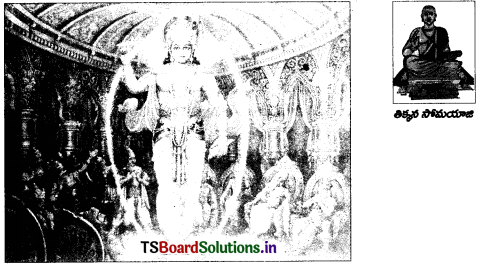
కవి పరిచయం
పాఠ్యాంశం పేరు : శ్రీకృష్ణ రాయబారం
కవి పేరు : తిక్కన సోమయాజి
గ్రంథం : మహాభారతం – ఉద్యోగపర్వం – తృతీయాశ్వాసంలోనిది
బిరుదులు : కవి బ్రహ్మ, ఉభయకవి మిత్రుడు
కాలం : 13వ శతాబ్ది (క్రీ.శ. 1205 నుండి 1288)
‘ఆస్థానం : నెల్లూరును పరిపాలించిన మనుమసిద్ధి ఆస్థానం.
ఇంటి పేరు : కొట్టరువు
రచనలు : వ్యాసభారతంలోని విరాటపర్వం నుండి స్వర్గారోహణ పర్వం వరకు – 15 పర్వాలు అనువదించాడు. నిర్వచనోత్తర రామాయణం, కృష్ణశతకం, విజయసేనం, కవివాగ్బంధం (కవిసార్వభౌమఛందం).
తిక్కన శైలి : తిక్కనది నాటకీయ శైలి, రాసాభ్యుచిత బంధం.
తిక్కనను ఆదరించిన రాజు : తిక్కన క్రీ.శ. 1205 నుండి 1288 వరకు నెల్లూరు మండలాన్ని పాలించిన, మనుమసిద్ధి యొక్క ఆస్థాన కవి.
మనుమసిద్ధికి తిరిగి
రాజ్యాన్ని ఇప్పించడం : తిక్కన తన జీవితకాలంలో దాయాదుల చేతిలో ఓటమిపాలైన మనుమసిద్ధికి అతని రాజ్యాన్ని తిరిగి ఇప్పించేందుకు, నాటి కాకతీయ ప్రభువైన గణపతిదేవుడి దగ్గరకు వెళ్ళి రాయబార కార్యాన్ని సఫలం చేశాడు.
హరిహరాద్వైత మతస్థాపన: సమాజం శాంతిగా ఉండేందుకు హరిహరాద్వైత సిద్ధాంతాన్ని పునఃప్రతిపాదించాడు. తమ సమకాలీన కవులందరిచేత సమున్నత గౌరవం పొందాడు. ఎందరో శిష్య ప్రశిష్యులను తన మార్గంలో నడిపించాడు.
తిక్కన గారి శిష్యుడు
కేతన చెప్పిన వివరాలు : కవిత్రయంలో ద్వితీయుడైనా కవితారచనలో అద్వితీయుడు తిక్కన సోమయాజి. తిక్కన శిష్యుడు కేతన దశకుమార చరిత్రలో తిక్కనను మయూర సన్నిభకవి, ఆర్యభోజ, భారవికల్పుడు, ఉభయ భాషాకర్త, త్రివిధకావ్య పారీణుడు అని పేర్కొన్నాడు.
పాఠ్యభాగ సందర్భం
పంచమ వేదంగా ప్రసిద్ధి పొందిన ఇతిహాసం మహాభారతం. శంతన మహారాజుకు. సత్యవతికి పుట్టిన సంతానం చనిపోయిన తరువాత వేదవ్యాసుని ద్వారా ధృతరాష్ట్ర, పాండురాజులు జన్మిస్తారు. పుట్టుకతో అంధుడైన ధృతరాష్ట్రునికి రాజయ్యే అవకాశం లేనందున పాండురాజుకు పట్టాభిషేకం చేస్తారు. పాండు రాజుమరణానంతరం ధృతరాష్ట్రున్ని తాత్కాలిక రాజునూ చేస్తారు. దుర్యోధనునికి రాజ్యంపై కోరిక పెరగడంతో వారిని చంపాలని ప్రయత్నిస్తాడు. దుర్యోధనుడు అసూయతో పాండవులను అనేకసార్లు కష్టనష్టాలకు గురిచేశాడు. లక్కయిల్లు దహనం, ద్రౌపదీ వస్త్రాపహరణం, మాయాజూదంతో పాండవులతో అరణ్యవాసం చేయించడం వంటి అనేక దుష్కృత్యాలకు దుర్యోధనుడు పాల్పడ్డాడు. అవన్నీ పూర్తయిన తరువాత తన అర్థరాజ్యం తనకిమ్మని రాయబారం పంపిస్తాడు. రాజు స్థానంలో ఉన్న ధృతరాష్ట్రుడు మౌనంగా కూర్చున్నాడు. సంజయుడు, ద్రుపద పురోహితుల రాయబారం ఇరుపక్షాల వద్ద జరిగినా ఫలితం లేకపోయింది. చివరకు శ్రీకృష్ణుడే రంగంలోకి దిగి ధృతరాష్ట్రునికి యుద్ధనష్టాలు, శాంతి గొప్పదనం, పాండవుల పరాక్రమం చెప్పేందుకు వెళ్ళిన సందర్భమే ‘శ్రీకృష్ణ రాయబారం’ అనే ప్రస్తుత మన పాఠ్యాంశం.

పాఠ్యభాగ సారాంశం
శ్రీకృష్ణుడు మేఘధ్వని వంటి గంభీరమైన తన కంఠధ్వనితో, దంతాల కాంతులు ప్రసరిస్తూ ఉండగా, ధృతరాష్ట్రుని సభలో ఉన్న వారందరూ శ్రద్ధగా వింటుండగా పాండవులు పంపిన సంధి సమాచారాన్ని ధృతరాష్ట్ర మహారాజుతో చెప్పాడు. “ఓ మహారాజా ! నీకు తెలియని విషయాలు ఏమున్నాయి ? అయినప్పటికీ, భరతవంశం సంతోషించేటట్లు నా ఇరు కుటుంబాల వారికి న్యాయమూ, పరమహితమూ చెప్పటం ఉచితమని నేనిక్కడికి వచ్చాను.
శ్రీకృష్ణుడు కురువంశ కీర్తిని గుర్తు చేయుట : కురునాథా ! పాండవ కౌరవులు పాలూ, నీరు లాగా కలిసిమెలిసి జీవించటం మంచిది. వారు కలిసిమెలిసి ఉండేటట్లు నడిపించవలసిన బాధ్యత తమరిది. పాండవులు వేరు, కౌరవులు వేరు అనే భేదభావన నీకు లేదు. మహారాజా ! మీ భరతవంశం ధర్మం, న్యాయం, సత్యం, ఐకమత్యం, గౌరవం, కారుణ్యం మొదలైన సద్గుణాలు గలిగి కీర్తి పొందింది. అట్టి వంశంలో నీవూ, నీ ప్రియ సహోదరుడు పాండురాజు సద్గుణాలతో గొప్ప పేరు పొందారు. నీ కుమారులు కూడా కీర్తి భారం వహింప జాలినవారు. కళ్యాణ స్వభావులు. ఇంత మంచి నడవడిగల వంశ సంప్రదాయం ఇపుడు తప్పడం ఎందుకు ?
యుద్ధం సంభవిస్తే జరిగే కీడుకు ధృతరాష్ట్రున్ని బాధ్యుణ్ణి చేయుట : ధృతరాష్ట్ర మహారాజా ! నీవు కురువంశంలో పెద్దవాడివి. ఈ వంశానికంతటికీ నీవే ఆధారం. నీ కుటుంబంలో ఎవ్వరెవ్వరి నడవడికలు, వాటిని బట్టి కలిగే మేలు, కీడు అంతా నీకే చెందుతాయి. కాబట్టి నీవు ఇరుకుటుంబాల వారి శ్రేయస్సును దృష్టిలో పెట్టుకొని జనులు మెచ్చేటట్లుగా వారిని చక్కదిద్దవలసిన బాధ్యత నీపై ఉంది. రాజా ! దుర్యోధనాదులైన వీరు ధర్మపరులుగాక, సత్కార్యాలు చేయక ఇట్లా ఉంటే మహార్థసిద్ధికి దూరమవుతామని తలచటం లేదు. మీ వంశ నడవడి ఇట్టిది కాదు అని తెలిసి కూడా దారుణ బుద్ధితో బంధువుల మనస్సులు బాధ చెందేటట్లుగా ప్రవర్తిస్తున్నారు. కౌరవులు, పాండవులు ఒక మంచి నిర్ణయానికి వచ్చి, శాంతం వహించి, జీవించటం మంచిది. ఇట్లు వారు ప్రసన్న చిత్తులై ఉండటం నాకూ, నీకూ, కురువంశానికి, ఈ రాజ సమూహానికి, ఈ భూమండలానికి అంతటికి మంచిది. అట్లాకాక యుద్ధమే సంభవిస్తే మనందరికీ మహావిపత్తు కలుగుతుంది. కనుక రాజోత్తమా ! నా మాటలపై విశ్వాసముంచి తప్పక సంధి చేసుకోండి.
ఇరువైపులా గల బలాలను వారిని కలిపి ఉంచే ప్రయత్నం చేయుట : అక్కడున్న భీమార్జునులను యుద్ధరంగంలో వివరించి నిలువరించగలవారు ఇక్కడెందరున్నారు ? ఇక్కడున్న ద్రోణ, భీష్ముల పరాక్రమాన్ని ఎదుర్కొనగలవారు అక్కడ ఎందరున్నారు ? ఇట్లా ఉభయ పక్షాలలోని వీరులు యుద్ధంలో చావటం కన్న నీ బలగాలై కలిసి మెలిసి జీవించటం మంచిది. మహారాజా! ఏ విధంగానైనా వీరిని శాంతింపజేయుము. లోకంలోని రాజులందరూ నీ పాదపీఠాన్ని ప్రీతితో సేవిస్తుండగా సముద్రముచే చుట్టబడిన పుడమినంతటినీ నీవే ఏకచ్ఛత్రంగా పరిపాలించటం మంచిది. తల్లి తన బిడ్డల పట్ల శత్రుత్వం వహించటం ఎంత సమంజసమో నీవే ఆలోచించు. నీవు కురుపాండవుల విషయంలో శ్రద్ధ వహించకుంటే ఈ ఉభయవర్గాలకే కాదు, పుడమిలోని జనులందరికీ పాపం చేసినట్లే అవుతుంది. చివరకు దానివల్ల నీకే హాని కలుగుతుంది.
రాజా ! కురు పాండవులలో ఎవరికి మరణం సంప్రాప్తించినా, బాధలు కలిగినా నీకు దుఃఖం కలుగుతుంది. కౌరవులూ, పాండవులూ మంచి చదువరులు, పరాక్రమవంతులు, భుజదర్పం గలవారు గనుక ఎవ్వరూ వీరి నడ్డగించలేరు. ఇట్లాంటివారు తమలో తమకేర్పడిన కొరమాలిన యుద్ధంలో మరణించటానికి సిద్ధపడుతుండగా అడ్డుపడక చూస్తూ ఊరకుండటం నీ వంటి వారికి తగిన పని కాదు. ఇంత కోమలమైన శరీరాల నుండి మొనలుదేలిన బాణాలు ఆవలికి దూసుకొని వెళ్ళేటట్లు గ్రుచ్చుకోగా నేలమీద కూలటం చూచి సహించటం సరైనది కాదు. రాజా ! నీ గొప్పతనమును, రాజనీతిని, శాంతిని సమస్త ప్రజలు మెచ్చుకొనేటట్లు కురుపాండవులు సంగ్రామంలో నశించకుండా సంరక్షించుకొనుము,
పాండవుల సందేశాన్ని అందించుట : ధృతరాష్ట్ర మహారాజా ! పాండవులు తండ్రిలేని పిల్లలు. వారిని పసితనం నుంచి చక్కగా కాపాడావు. ఇప్పుడు వారిని కారణం లేకుండా మధ్యలోనే విడిచిపెట్టడం న్యాయం కాదు. పాండునందనులు నీకు పరమభక్తితో నమస్కరించి ఒకే గొంతుకతో నీకు చెప్పమని నాతో చెప్పి పంపిన మాటలు చెపుతాను వినుము. “తండ్రీ ! నీ ఇష్టప్రకారం పన్నెండు సంవత్సరాలు అరణ్యాలలో నివసించాము. పదమూడవ సంవత్సరం విరాట మహారాజు దగ్గర అజ్ఞాతవాసం చేశాము. ఈ విధంగా ఒప్పందాన్ని నెరవేర్చాము. మేము రాజ్యంలో సగపాలు పొందగలమని దృఢనిశ్చయంతో ఉన్నాము. మాకు తల్లి, తండ్రి, చుట్టములు వెయ్యేల సర్వవిధ రక్షకులు మీరే. మావల్ల ఏమైనా అపరాధముంటే కోపించి చక్కబెట్టండి”.
యుద్ధాన్ని తప్పించకుంటే దైవం చూసుకుంటుందని హెచ్చరిక : ఉత్తమమైన ధర్మం, నిర్మలమైన సత్యం పాపం చేతను, అబద్ధం చేత లక్ష్యాన్ని చేరలేని స్థితిలో వాటిని రక్షించే శక్తి ఉన్నా, ఎవరు అడ్డుపడక అశ్రద్ధ వహిస్తారో అది వారలకే హానికరమవుతుంది. ఆ స్థితిలో భగవంతుడు ధర్మమును ఉద్ధరించటానికి, సత్యానికి శుభం కలిగించటానికి ముందుకు వస్తాడు.
పాండవులు సభలోని పెద్దలకు నన్ను చెప్పమని కోరినమాటలు చెప్పాను. మహారాజా ! నీవూ, సభలోని రాజులూ ఇందుకు బదులేమి చెపుతారో చెప్పండి. నేటి నీతి ధర్మాలనూ, బాంధవ్యాన్ని ముందుంచుకొని మనోవాక్కులు ఏకరూపంగా ఉన్న సత్యమునే చెప్పాను. నే చెప్పిన పద్ధతి మీకు మేలు గలిగిస్తుంది. కోపం, గర్వం, ద్వేషం వదలి నేను చెప్పినట్లు చేయండి.
పాండవుల ఔన్నత్యాన్ని వివరించుట : రాజా ! పాండవుల తండ్రి భాగం పాండవులకిచ్చి, నీ రాజ్యభాగం నీ కుమారులు, నీ మనుమళ్ళూ హాయిగా అనుభవిస్తూ ఉంటే చుట్టాలూ, స్నేహితులూ, సత్పురుషులు అందరు మిమ్ములను కొనియాడుతారు. మహారాజా ! ధర్మజుడి న్యాయమూ, ధర్మమూ, సత్యప్రవృత్తి నీకు తెలుసు. అయినప్పటికీ స్పష్టంగా చెపుతాను విను. అతడు ఇంద్రప్రస్థపురంలో ఉంటూ నీకు గౌరవ ఖ్యాతులు కలిగించడానికి రాజులను ఓడించి వారందరు నిన్ను కొలిచేటట్లు చేయటానికి గొప్పగా దిగ్విజయ యాత్ర చేశాడు. సిరిసంపదలతో తులతూగుతూ నిమ్మళంగా ఉన్నప్పుడు
నీ తనయుడూ, అతని మంత్రులూ చేరి శకునిచే జూదమాడించి ధర్మజుడి సంపదనెల్ల హరింపచేశాడు. అంతటితో తృప్తిపడక నిండుసభలో ద్రౌపదిని పరాభవించారు. దుర్యోధనుడి దుష్కృత్యాలకు నీవు సమ్మతించావు. ధర్మరాజు తనకేర్పడిన సంకటాన్ని గమనించి సత్యం తప్పక తన ఆజ్ఞచేత భీమార్జునులు బలముడిగి క్రుంగిపోగా కంటి నుండి కారుతున్న కన్నీటిని ఎడమచేతితో తుడుచుకొంటూ ఘోరారణ్యాలకు వెళ్ళాడు. అక్కడ దుఃఖాలలో మునిగి దైన్యం అనుభవిస్తూ ప్రతిజ్ఞను సక్రమంగా నెరవేర్చాడు. అయినా మీతో కలిసి జీవించవలెనని కోరుకుంటున్నాడు.
ధర్మరాజుకు సాటియైన వాడు ధర్మరాజే. ఆయన శాంతస్వభావం, అణకువ, సత్యనిష్ట ఇంతకుమునుపు ఏ రాజులలో కూడా కానరాదు. మంచితనం గల ధృతరాష్ట్ర మహారాజా ! నీ బిడ్డలైన కురుపాండవుల మేలు గోరి నేను ఇన్ని మాటలు చెప్పవలసి వచ్చింది, నీ పుత్రుడైన దుర్యోధనుడి మనసులో ఉన్న పరమదురాశను తొలగించి, పాండవులను నీ చెంతకు పిలిపించుకొనుము. మహారాజా ! పాండవులు ఎంతటి శాంత స్వభావులో అంతటి వీరాగ్రేసరులు. వారు నీ పాదసేవ చేయటానికి సంసిద్ధంగా ఉన్నారు. వారికి మీతో కలిసి మెలిసి ఉండటం ఇష్టంలేకపోతే ఈపాటికి యుద్ధానికి బయలుదేరి వచ్చేవారు. సంధి, సంగ్రామం ఈ రెండింటిలో మీకేది హితమని తోస్తుందో దానిని నిర్ణయించి చెప్పండి.
శ్రీకృష్ణుడి మాటలు వినగానే సభ్యులందరి శరీరాలు గగుర్పాటు వహించాయి. వారు మనస్సులలో ఎంతో సంతోషించి, నారాయణుడెంత చక్కగా మాట్లాడాడు ! శౌరి మాటలకు బదులు చెప్పగల నీతి నిపుణుడు, ధీరుడు, ఉపాయశాలి ఈ కొలువులో ఎవరున్నారు ? అని కదలక మెదలక నోరు విప్పక అట్లాగే ఉండిపోయారు.
